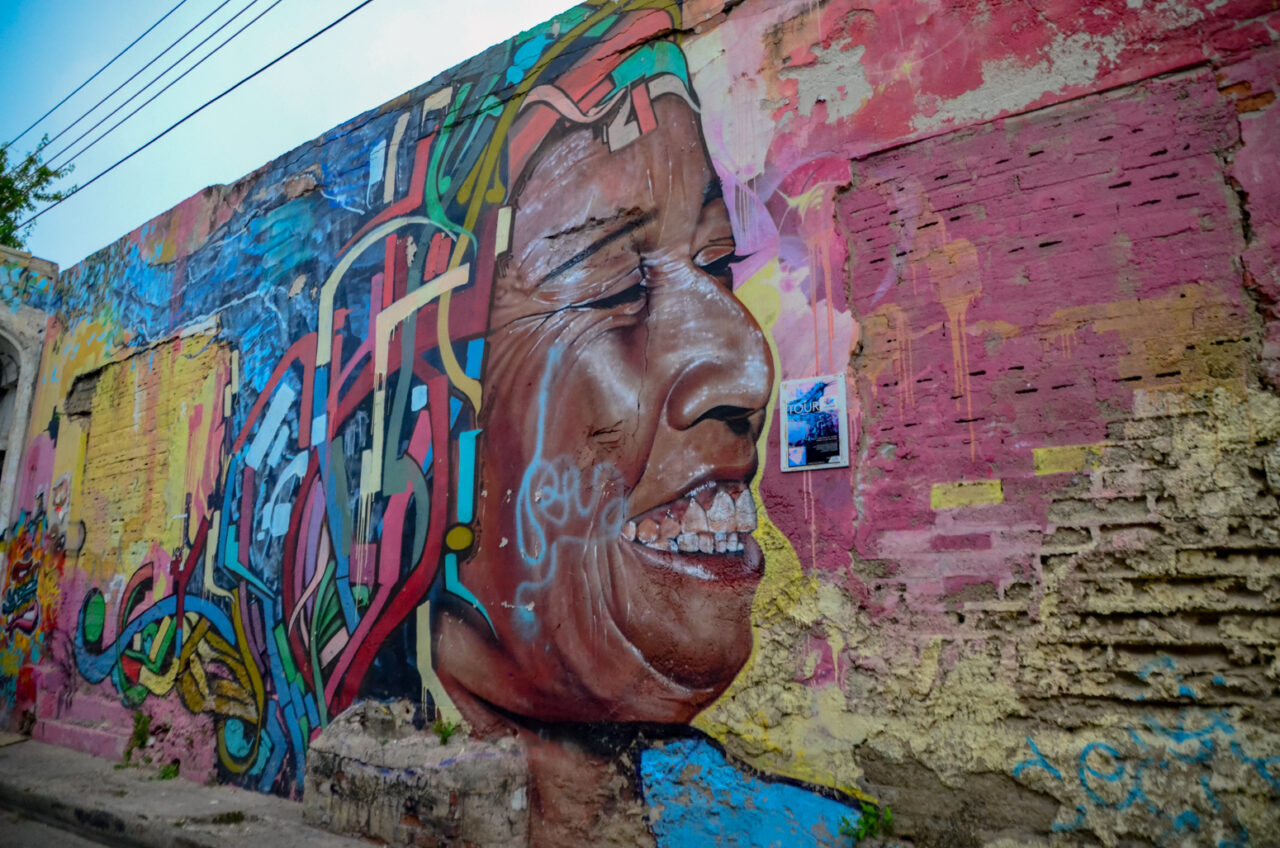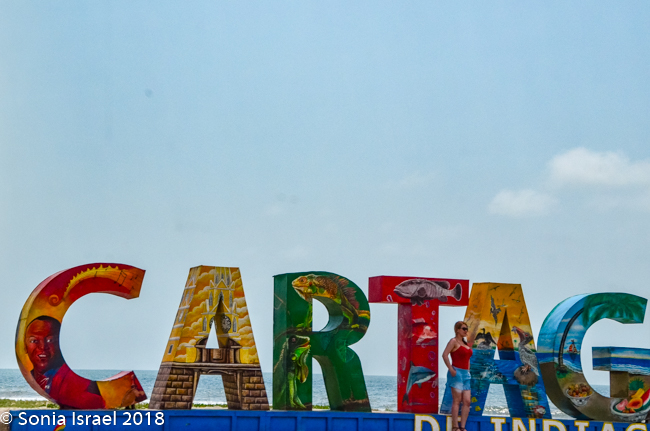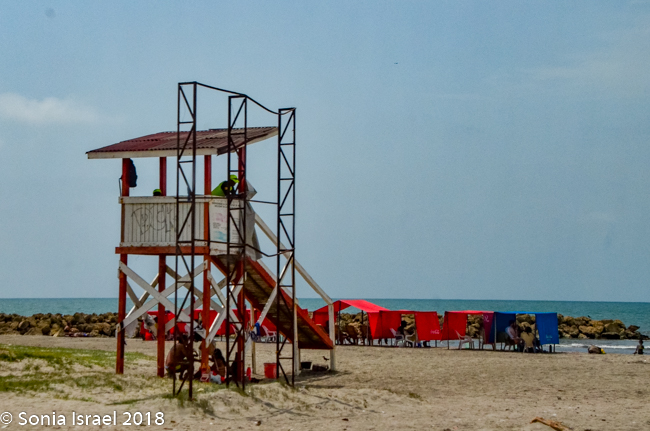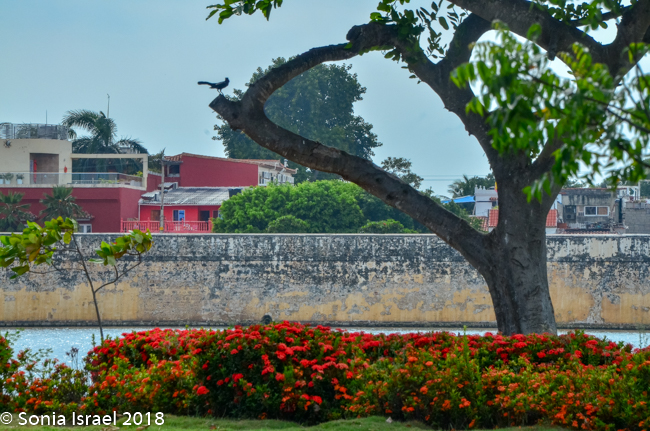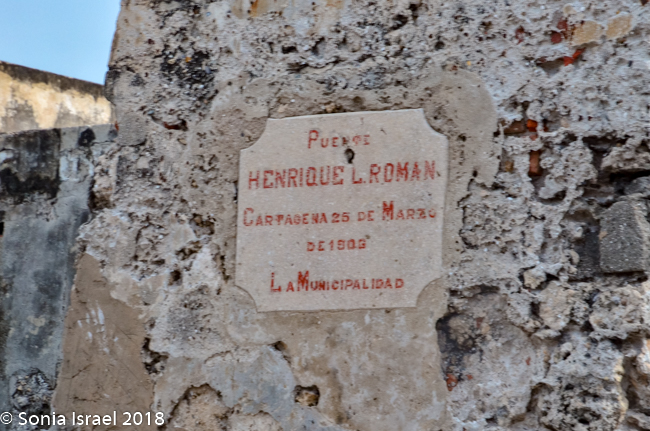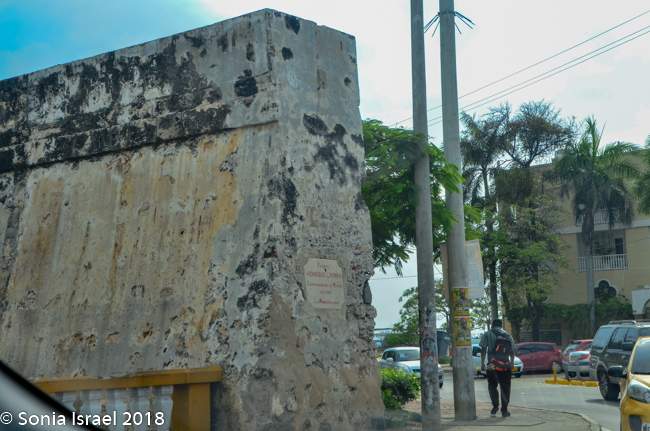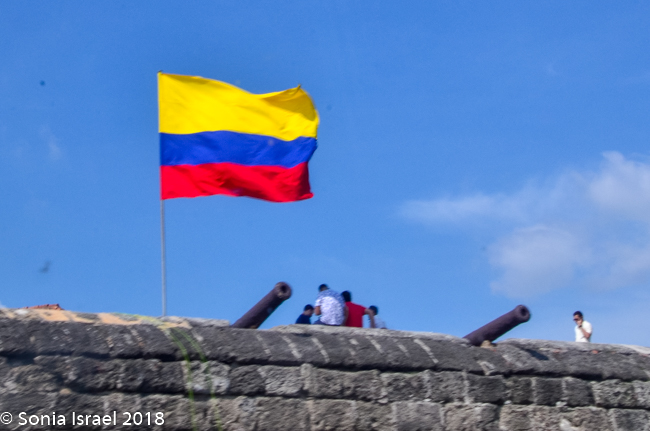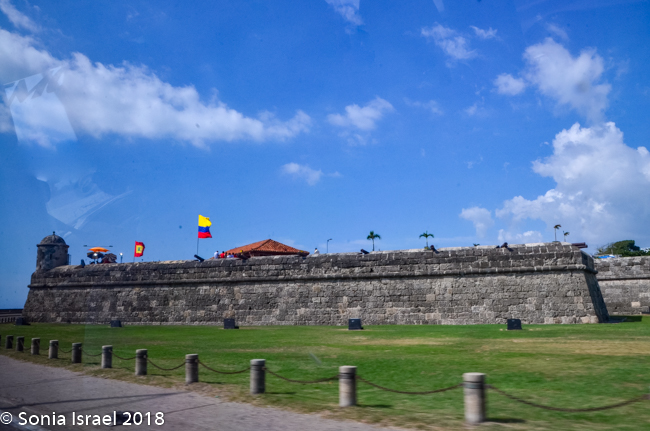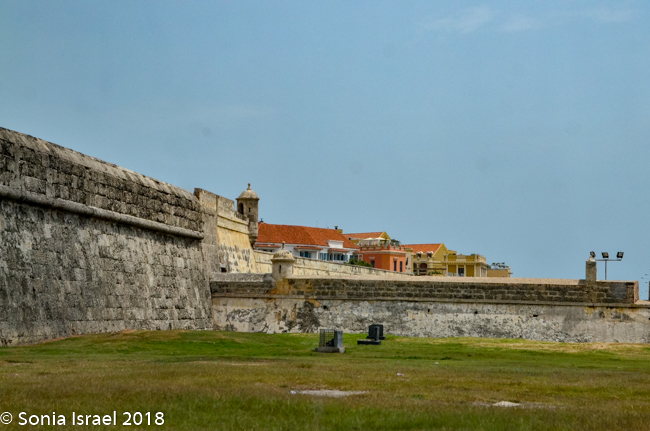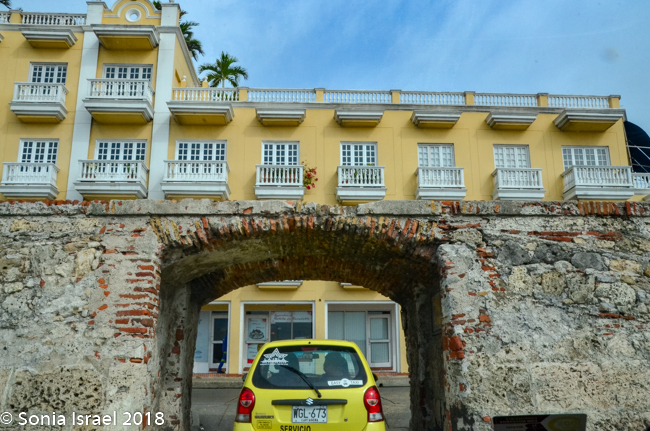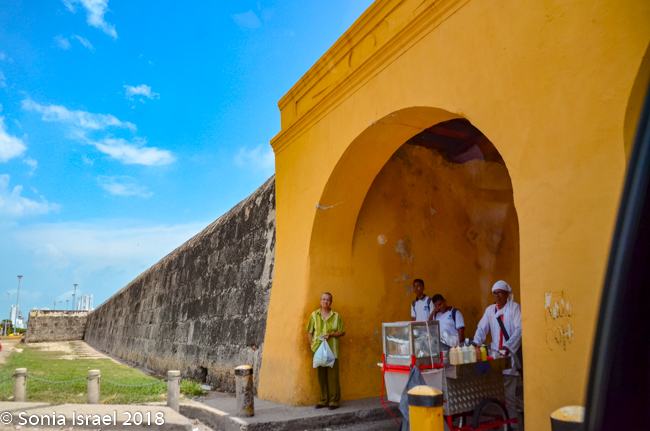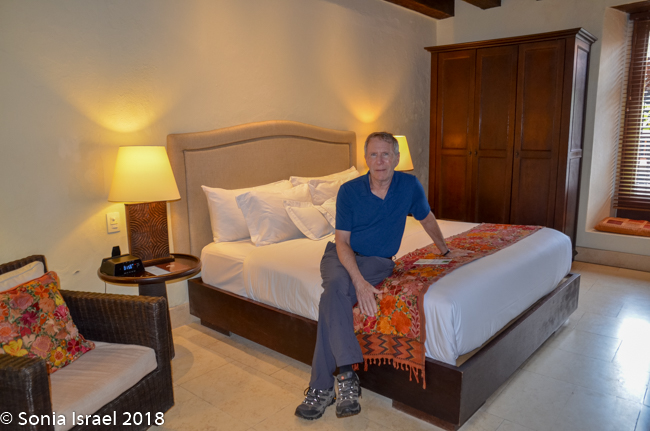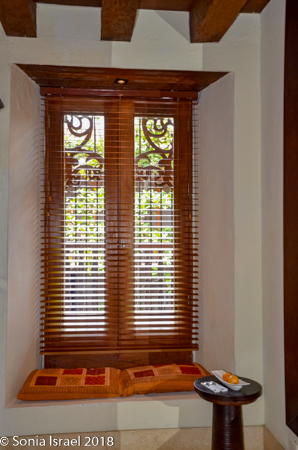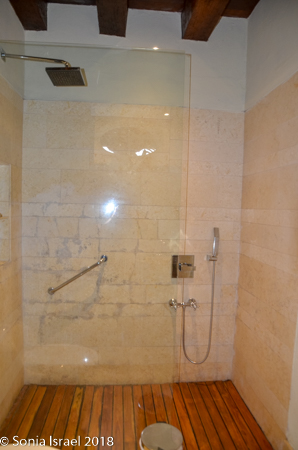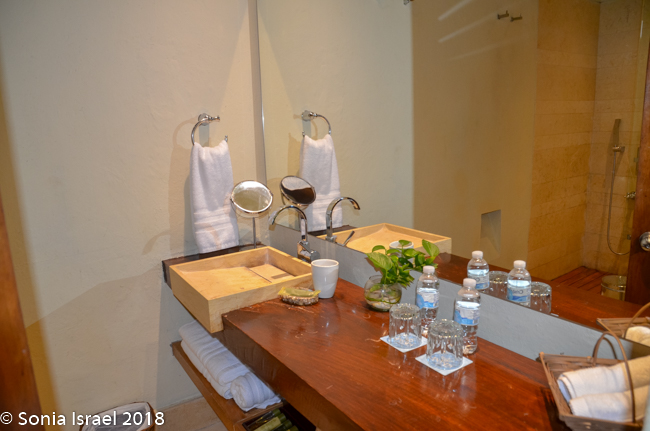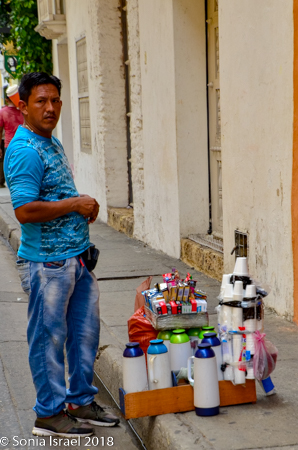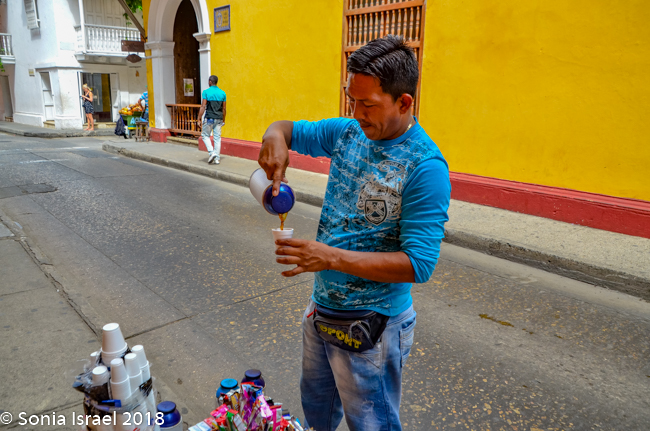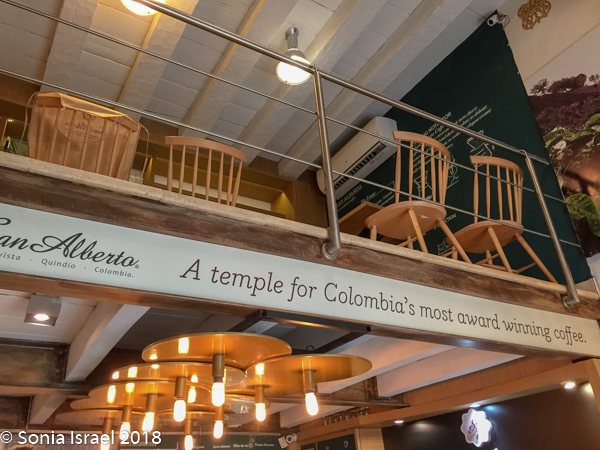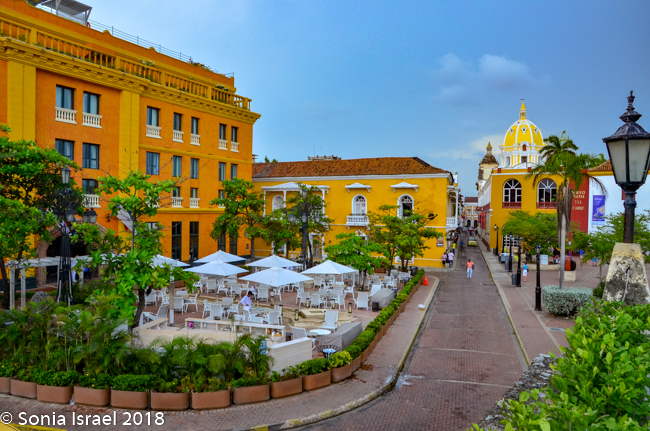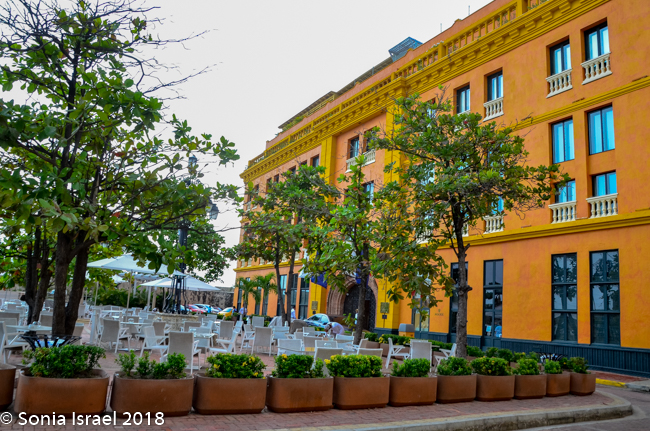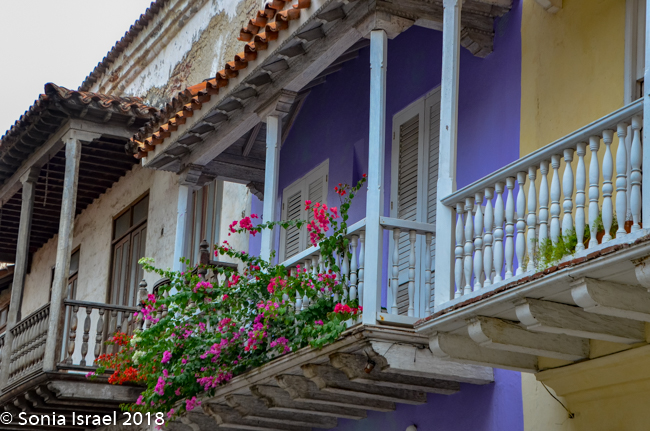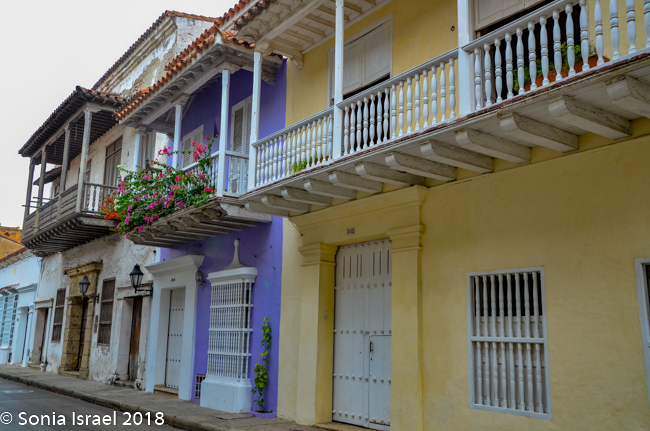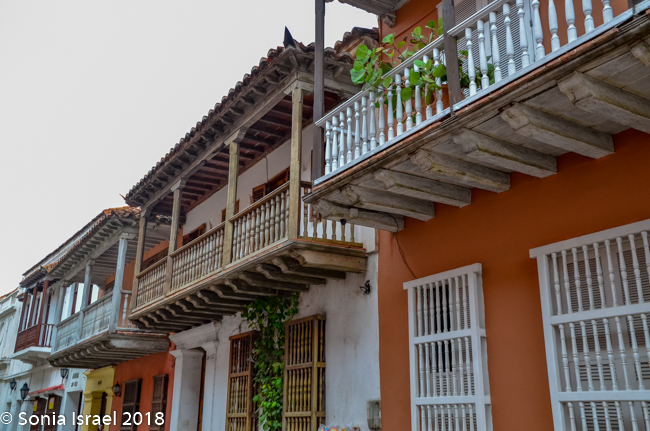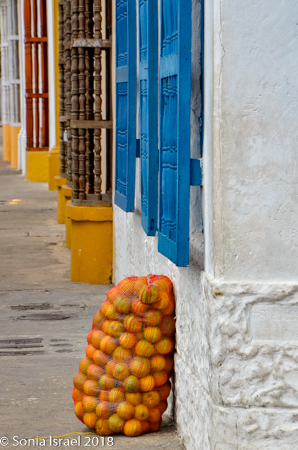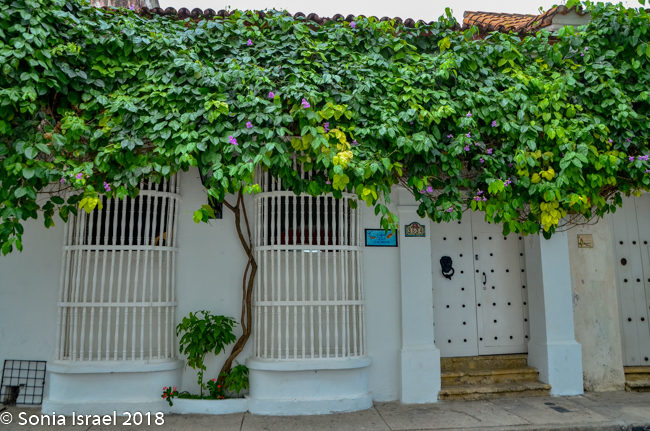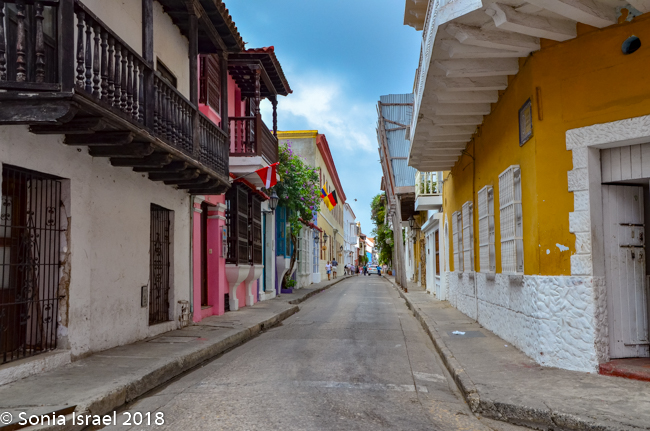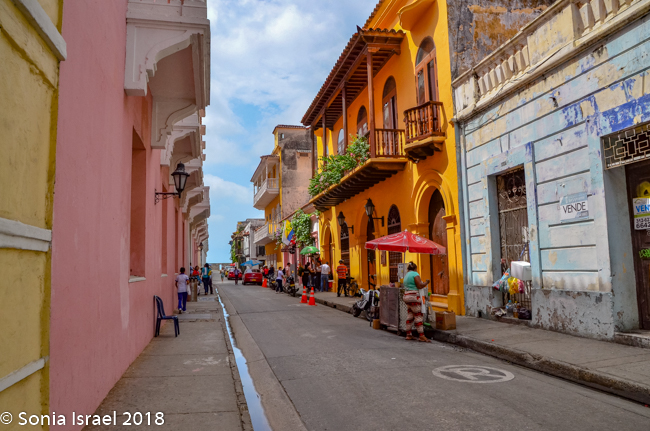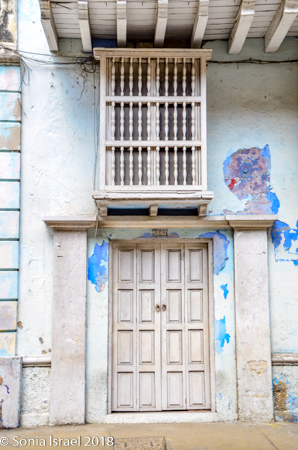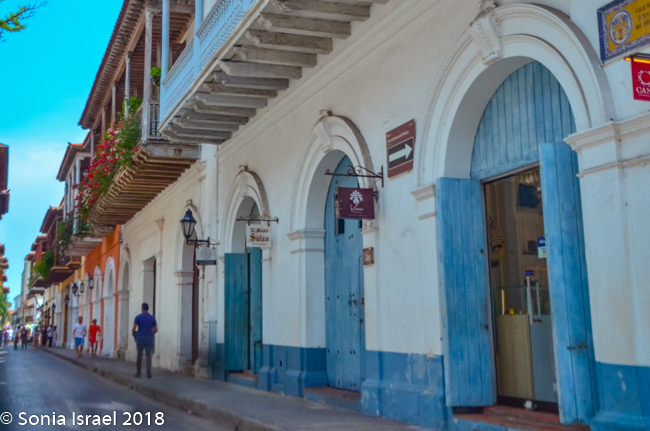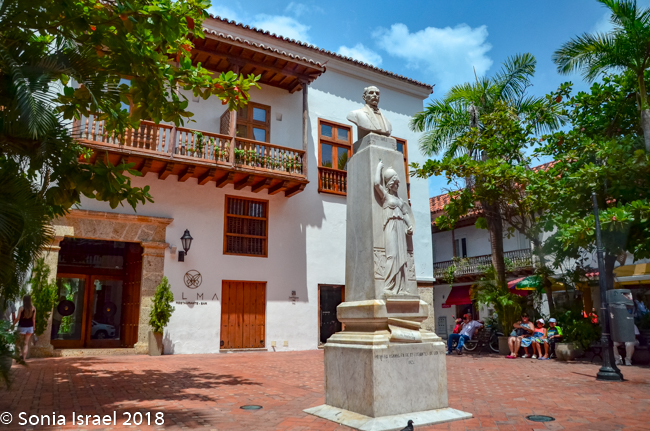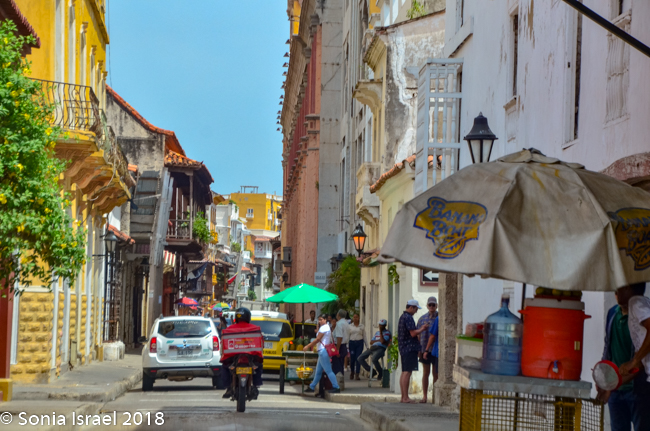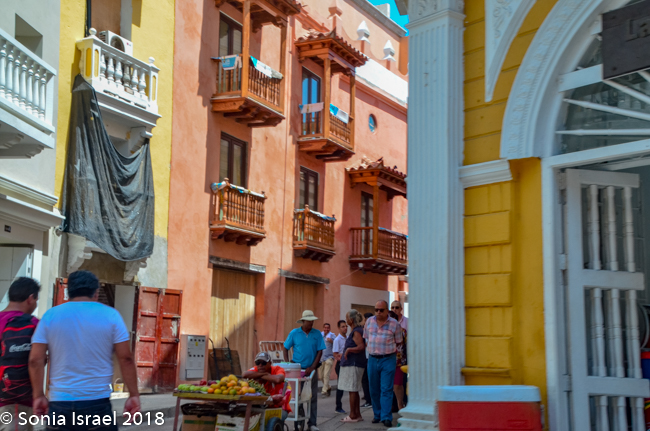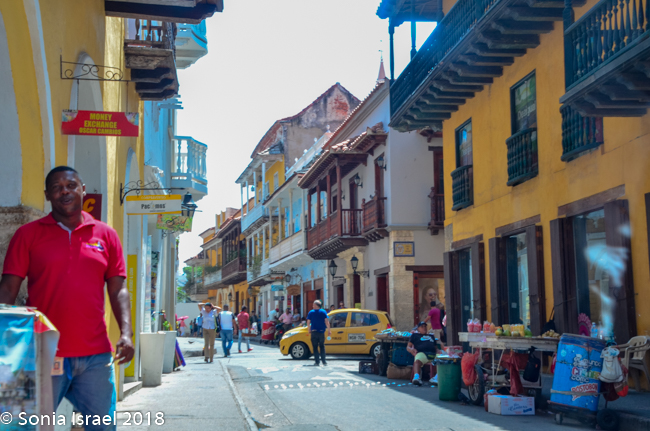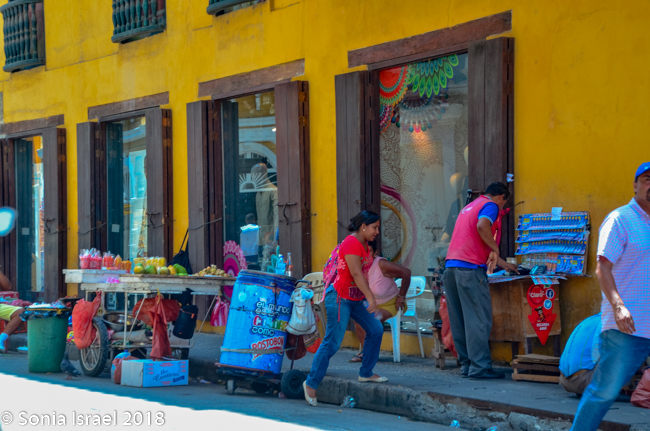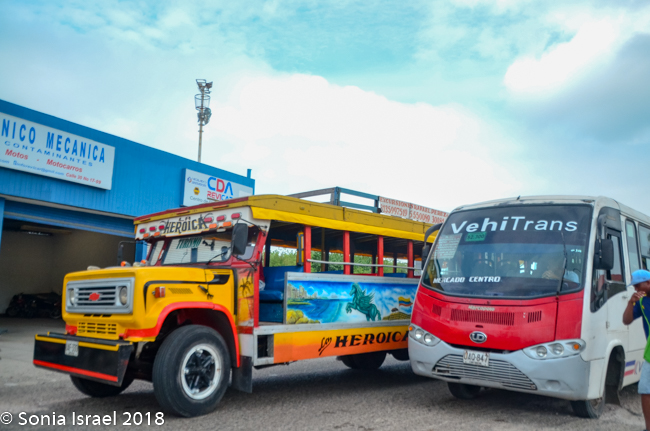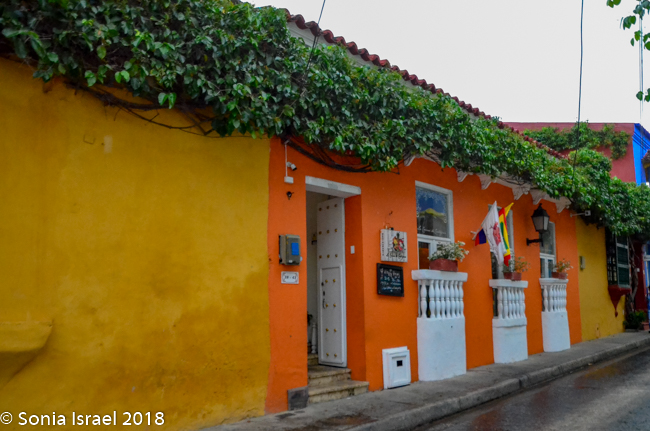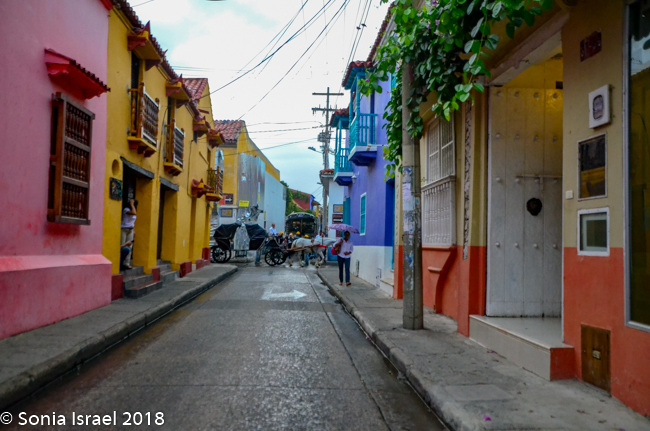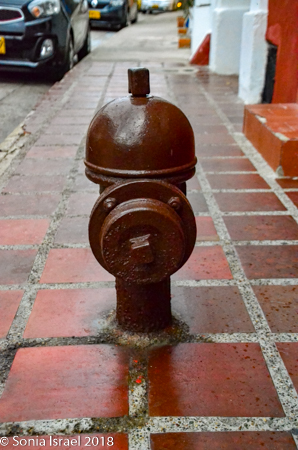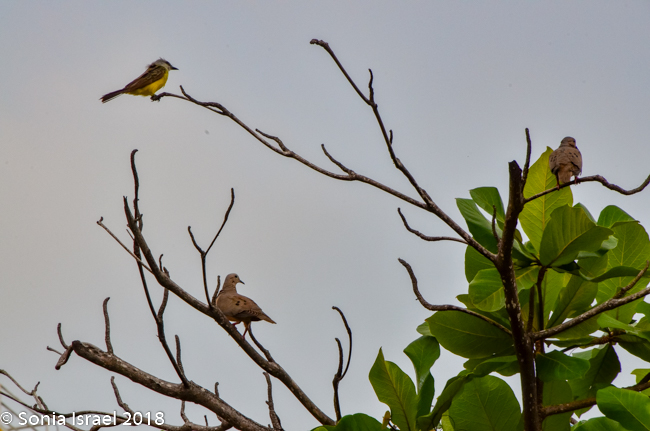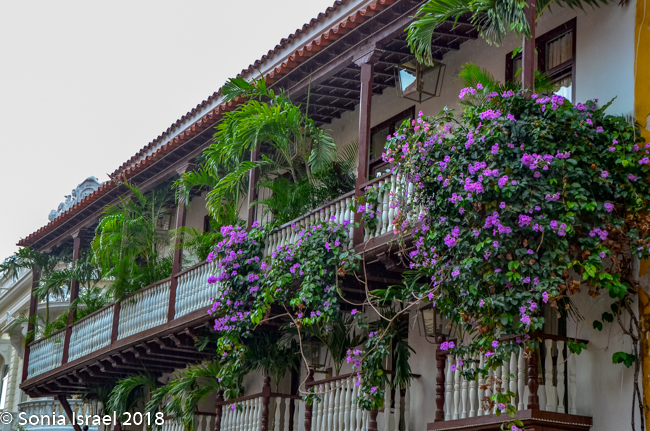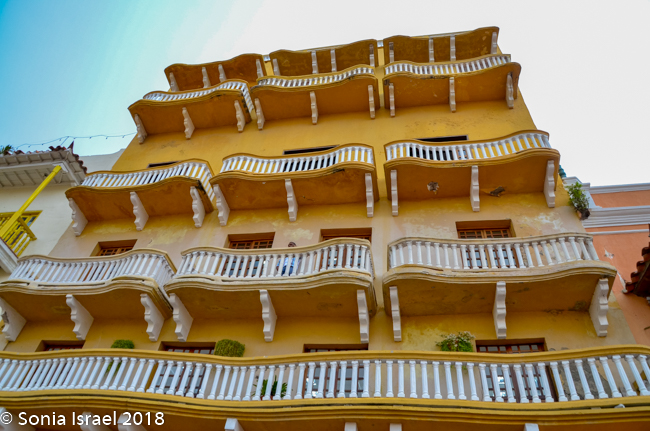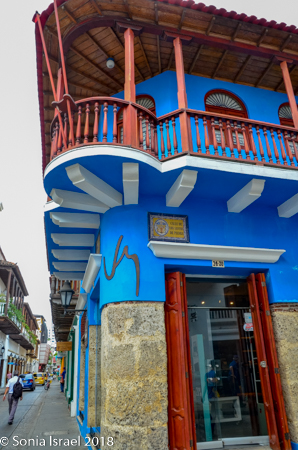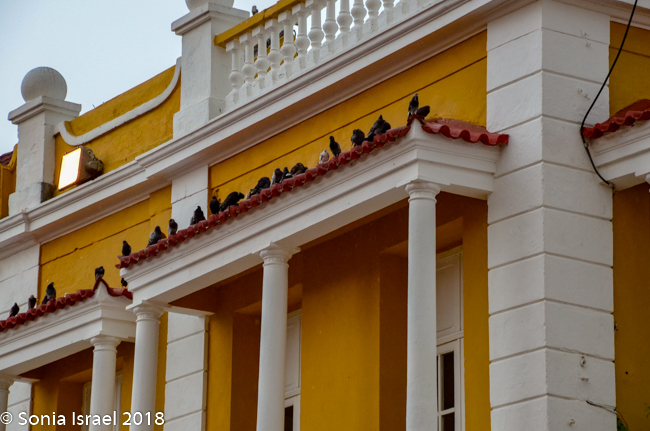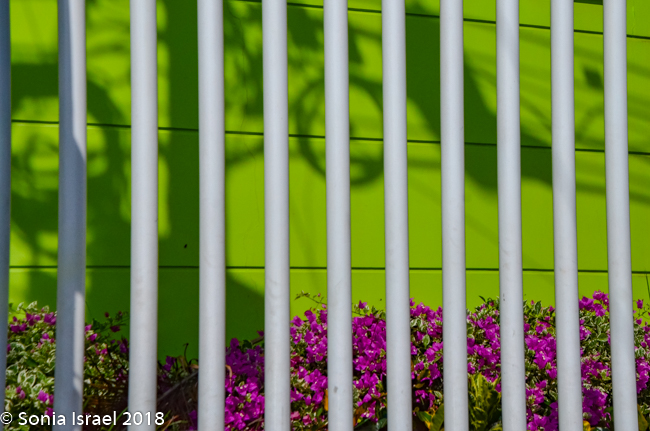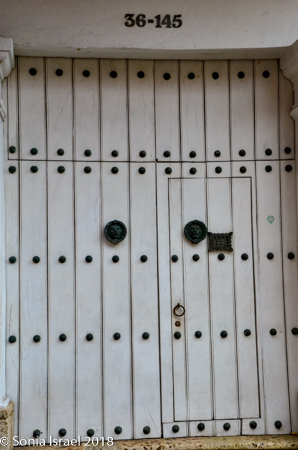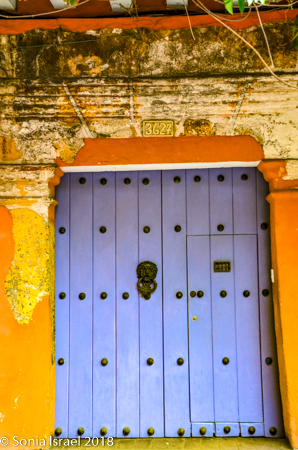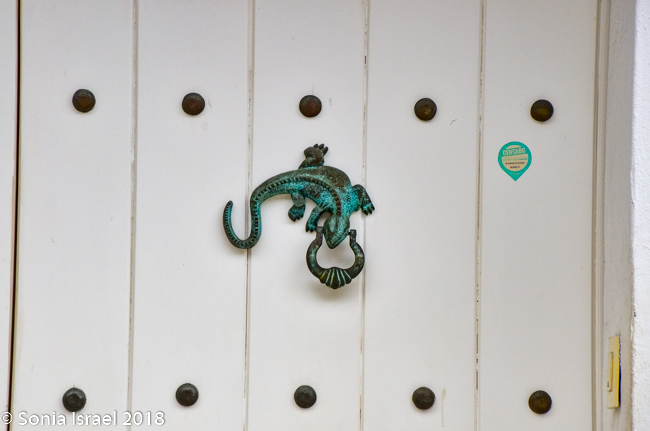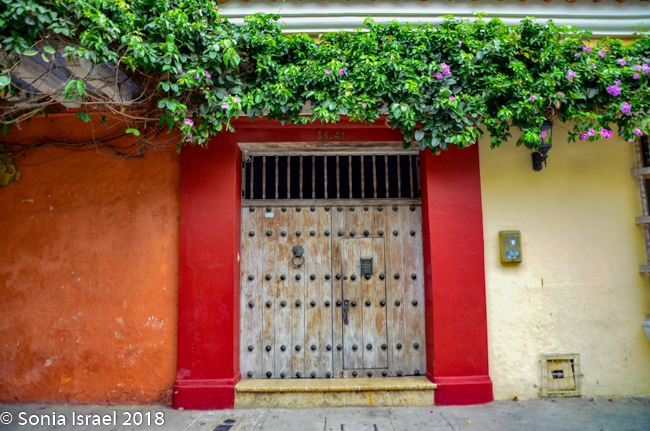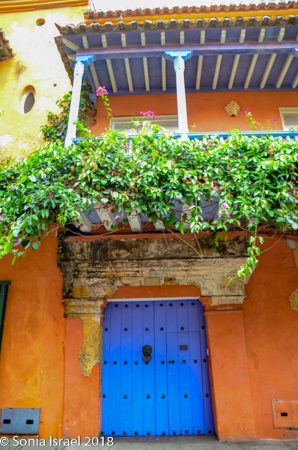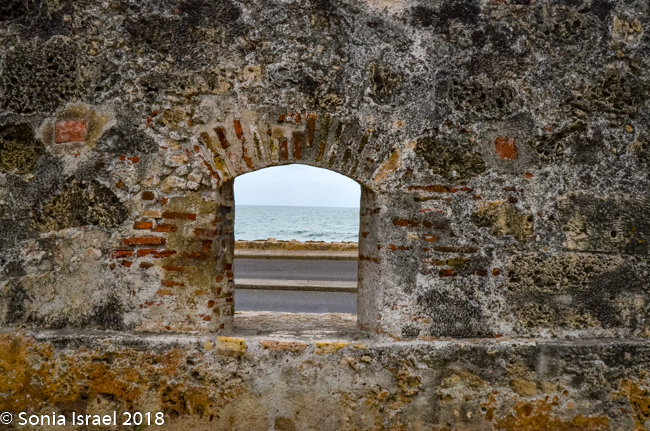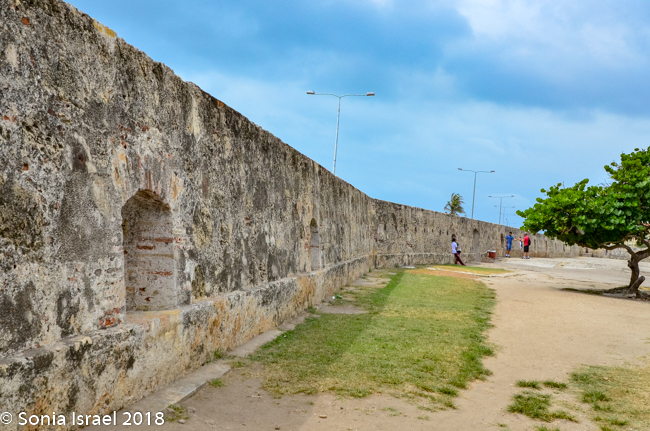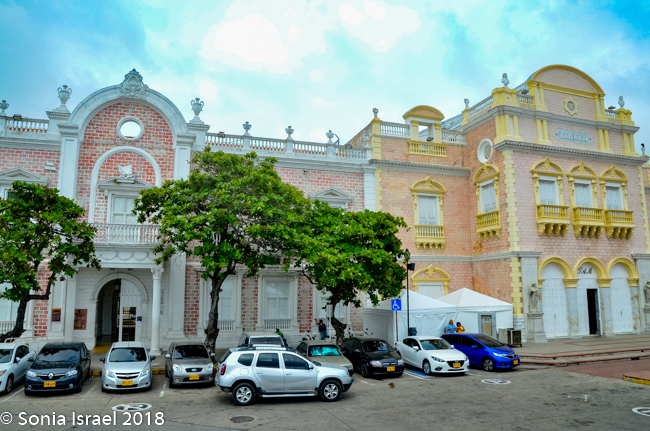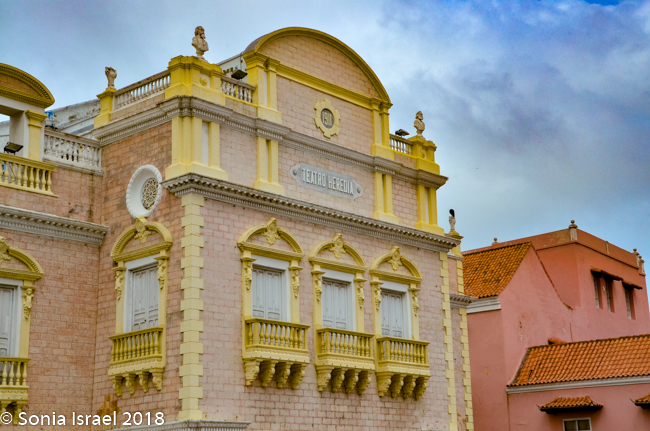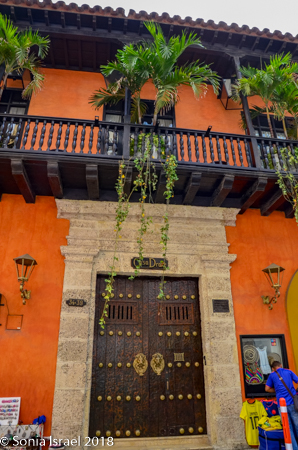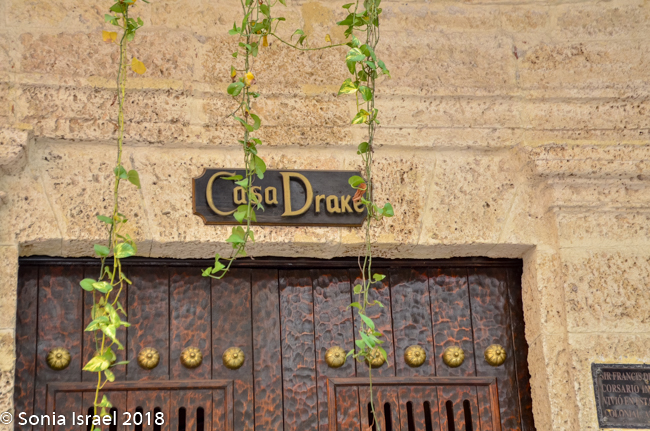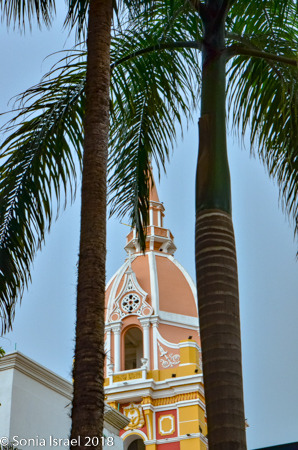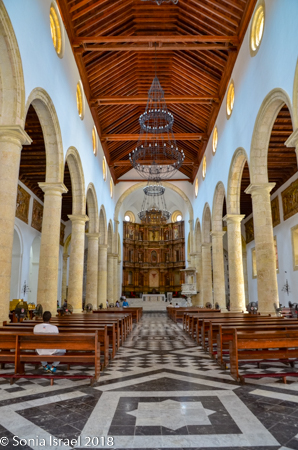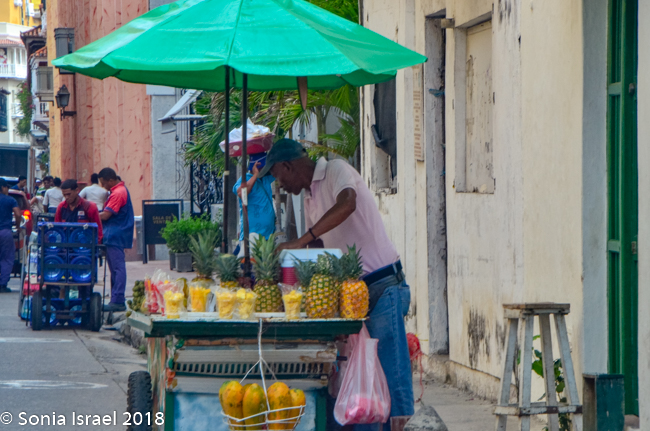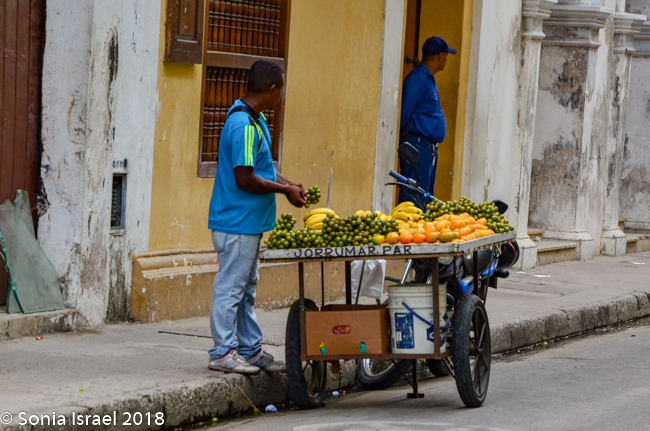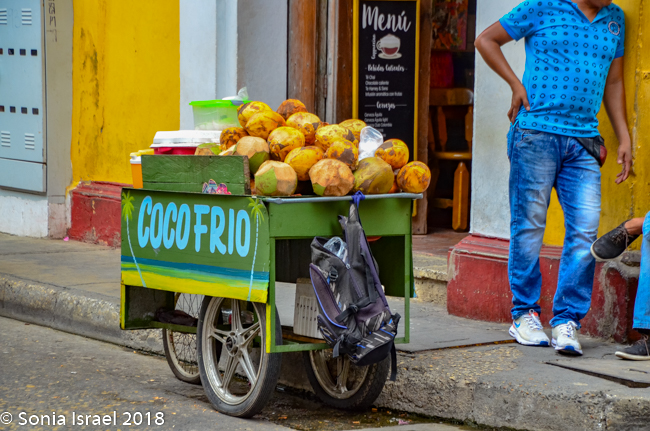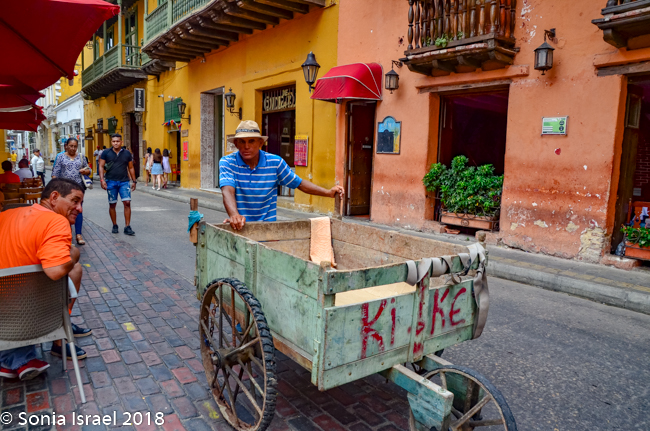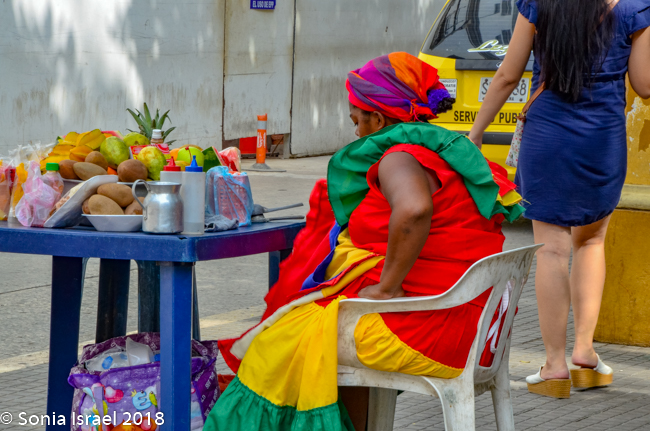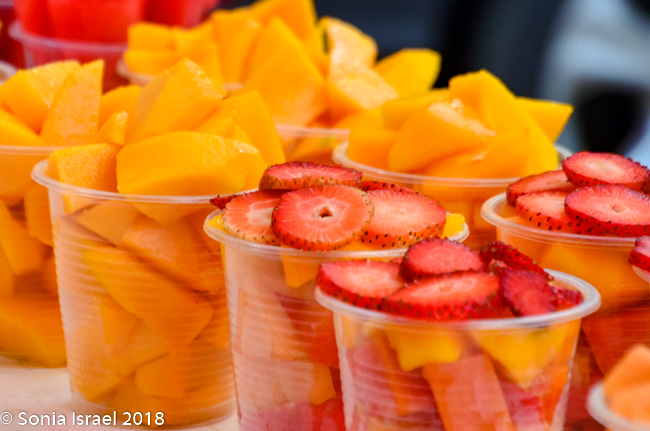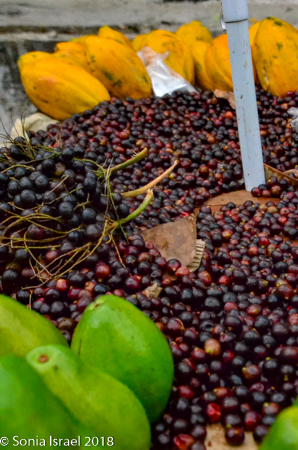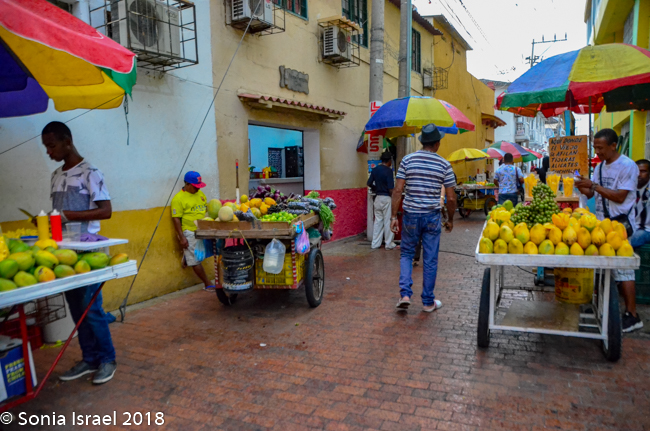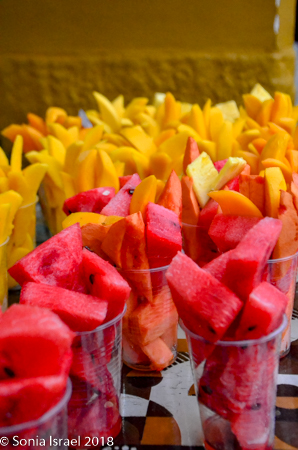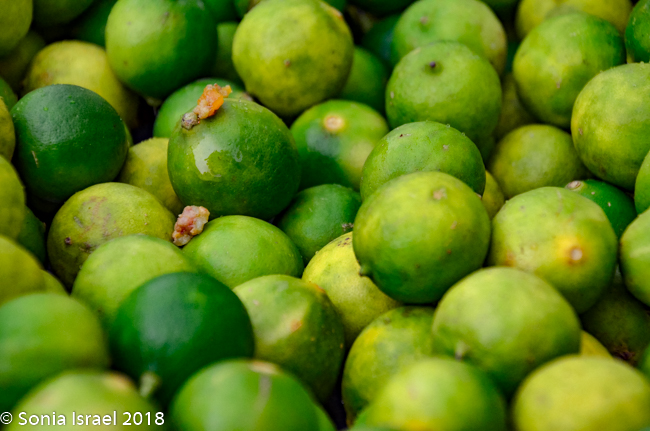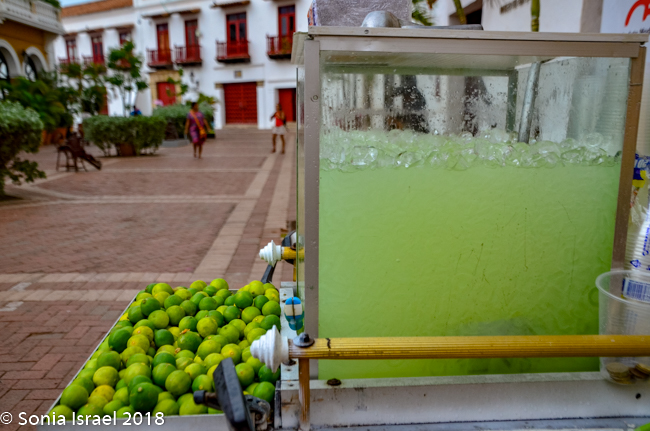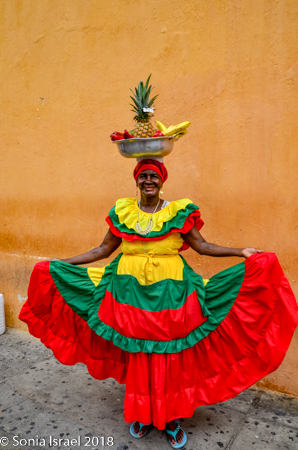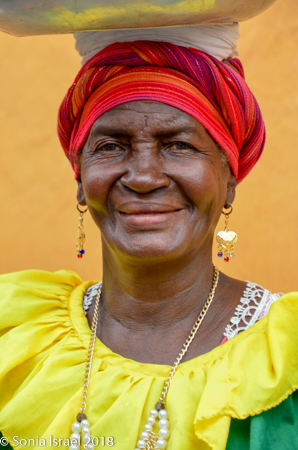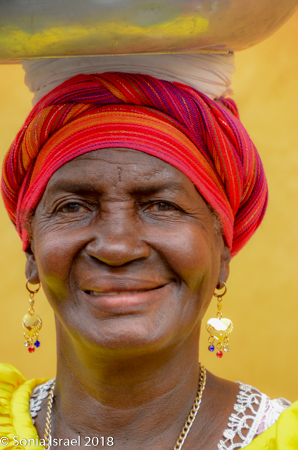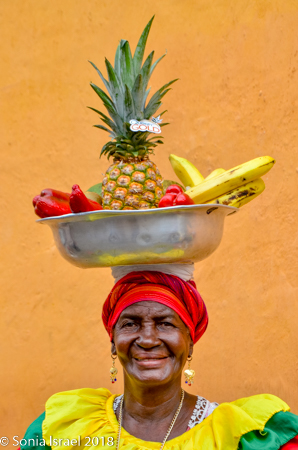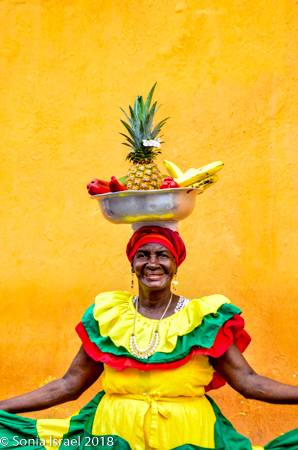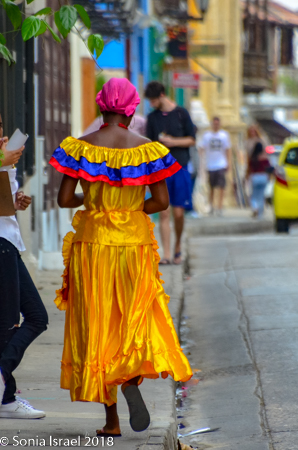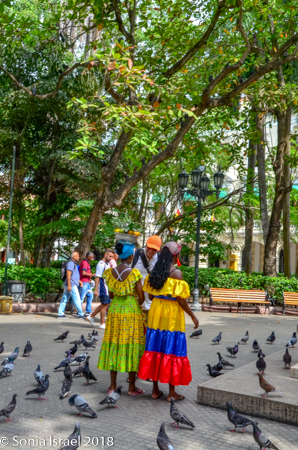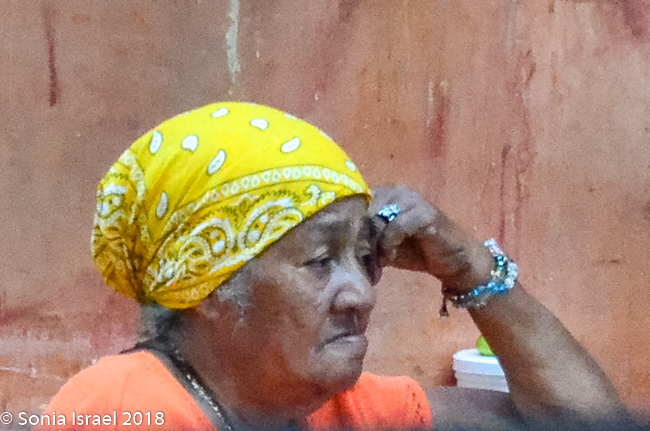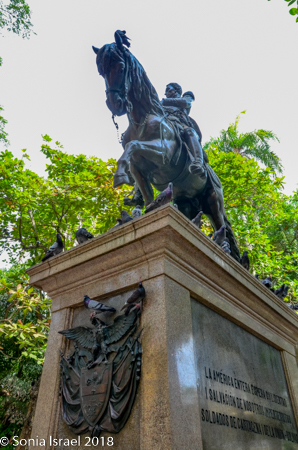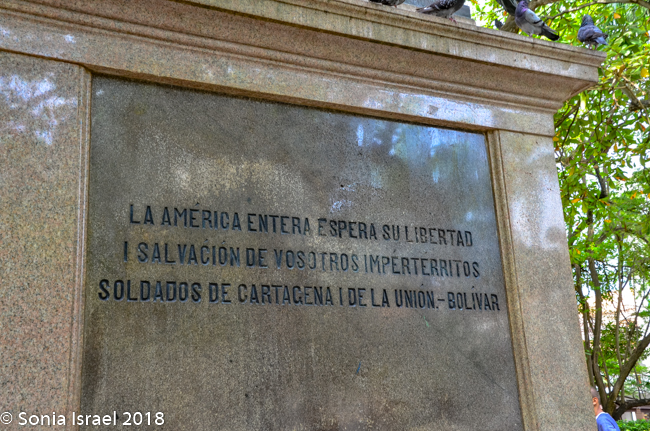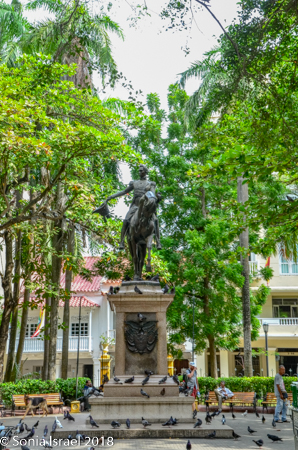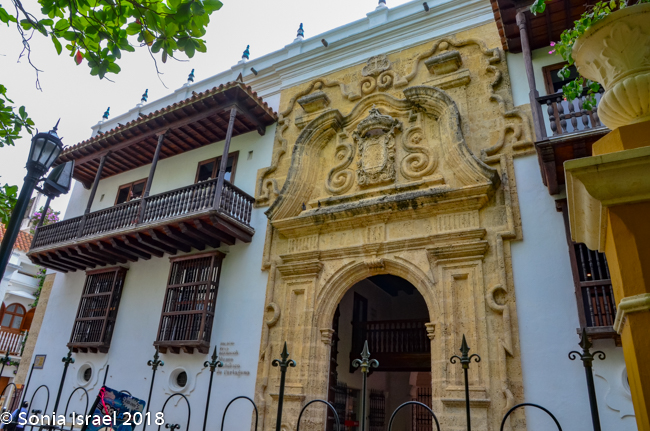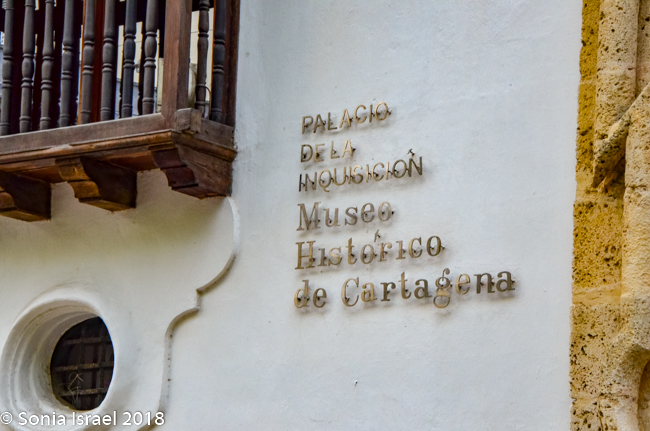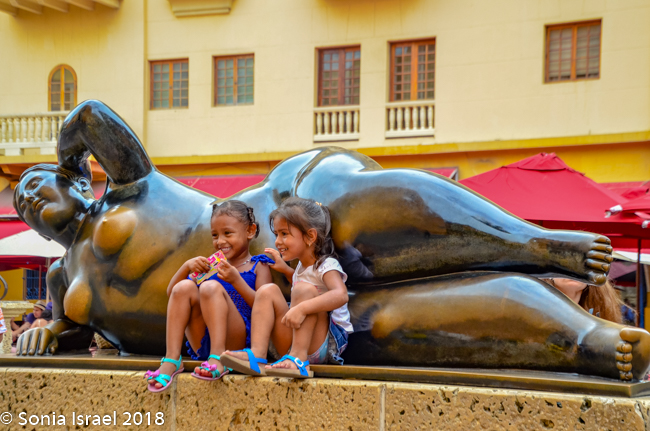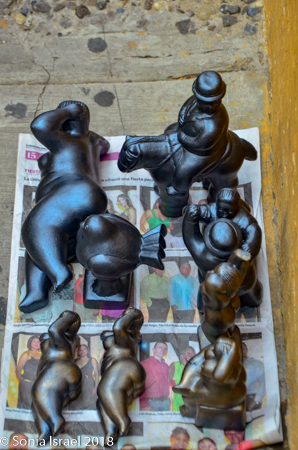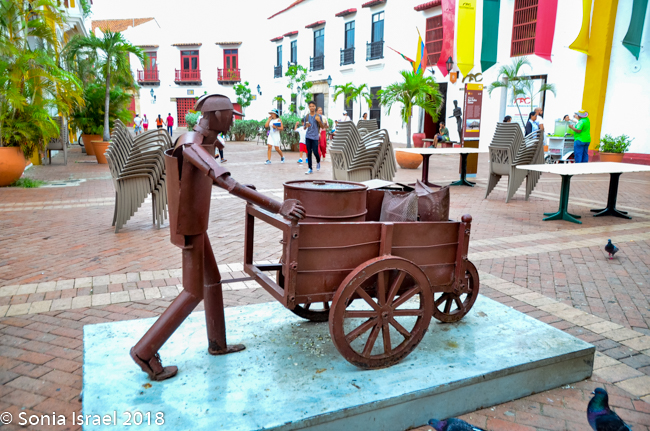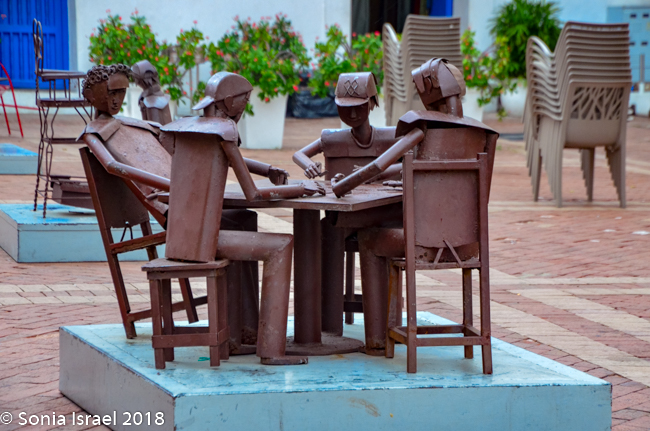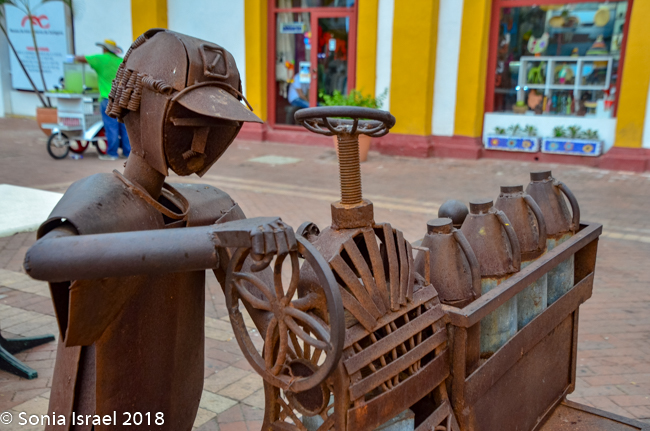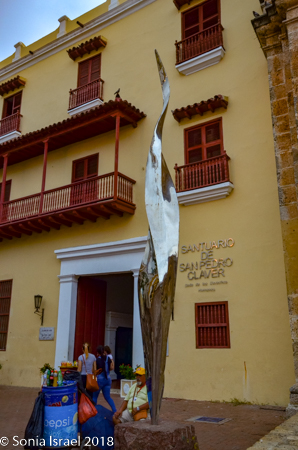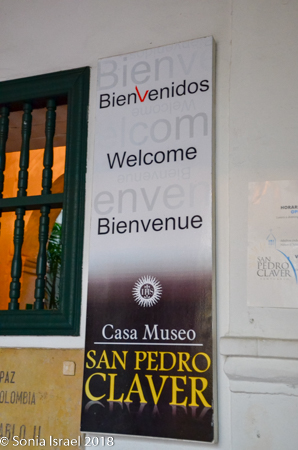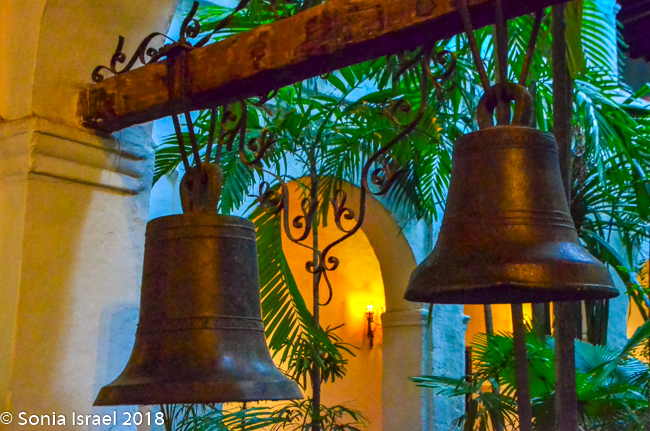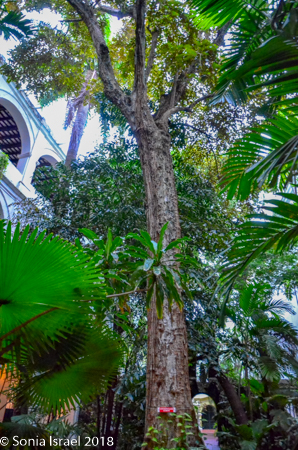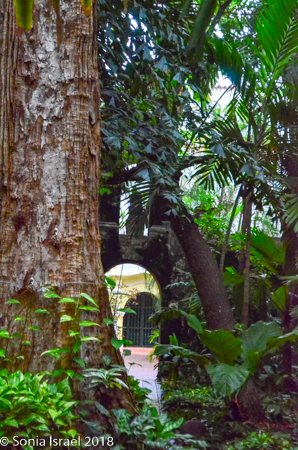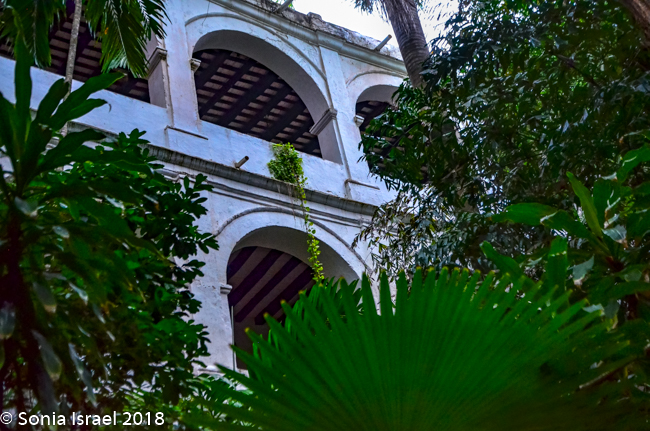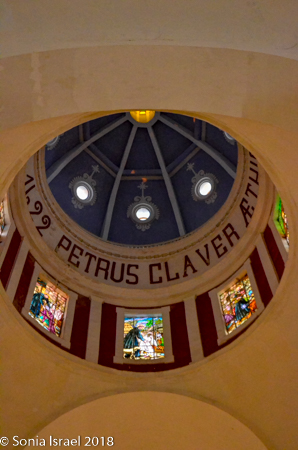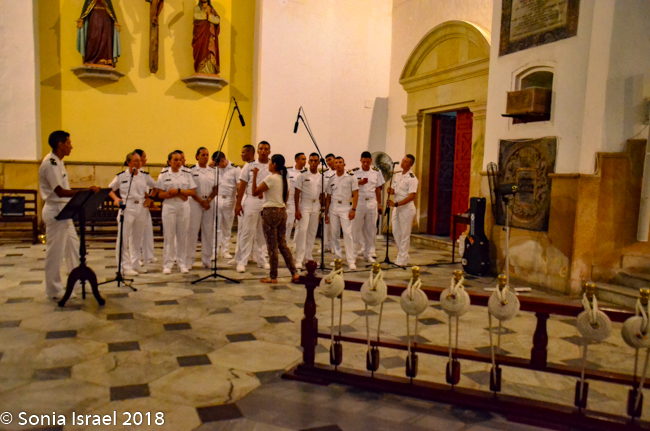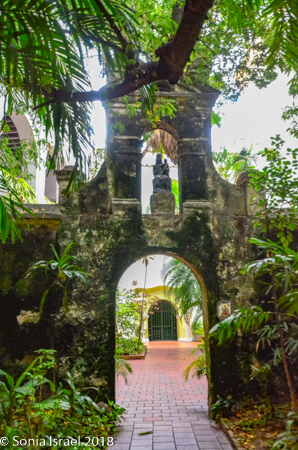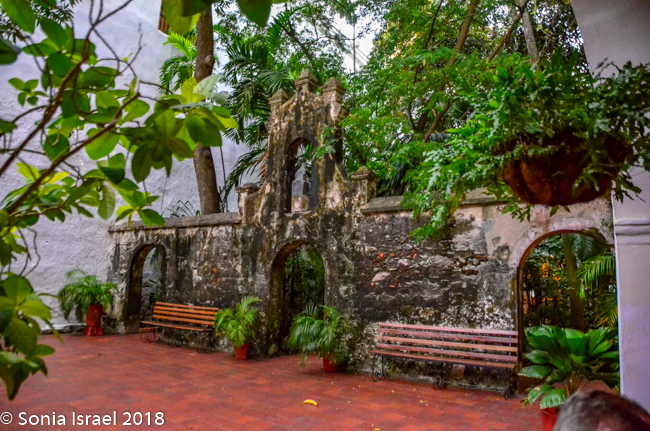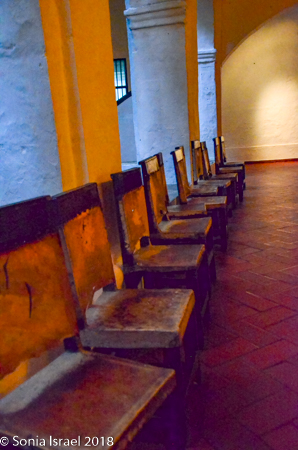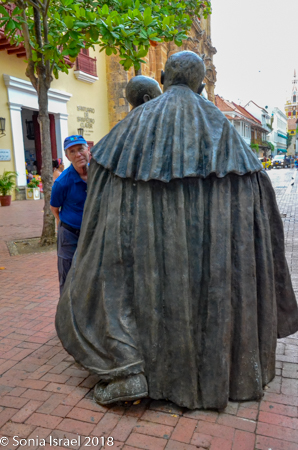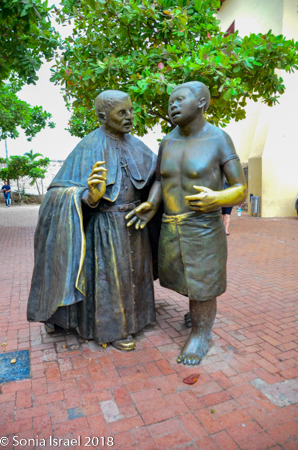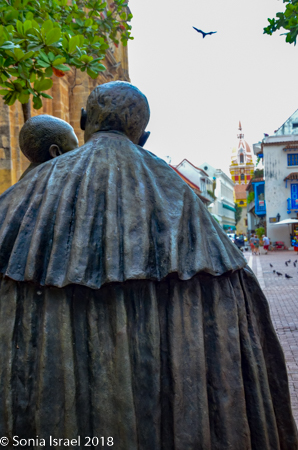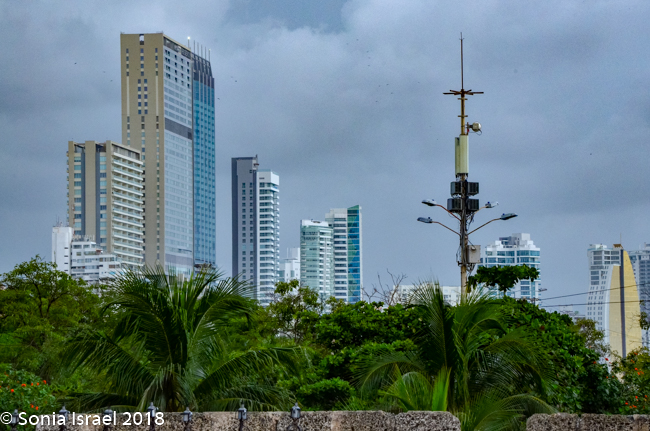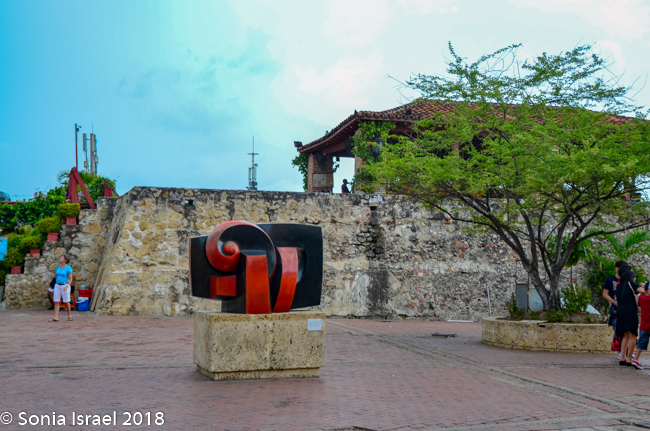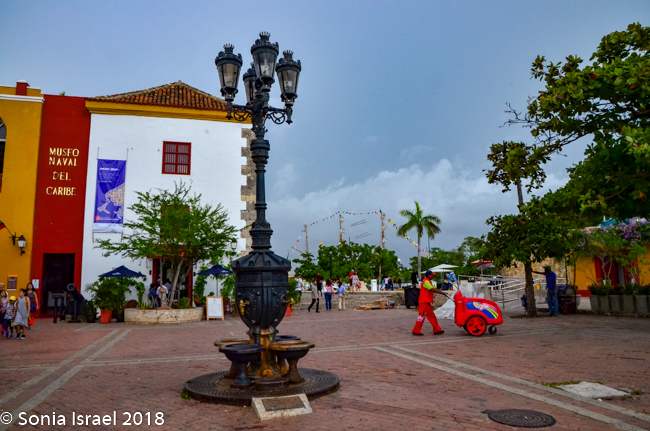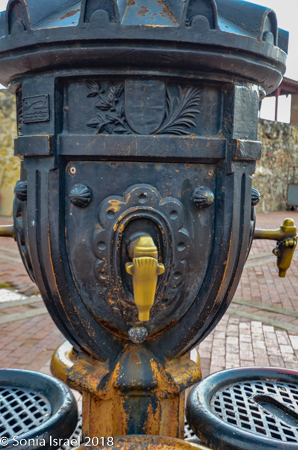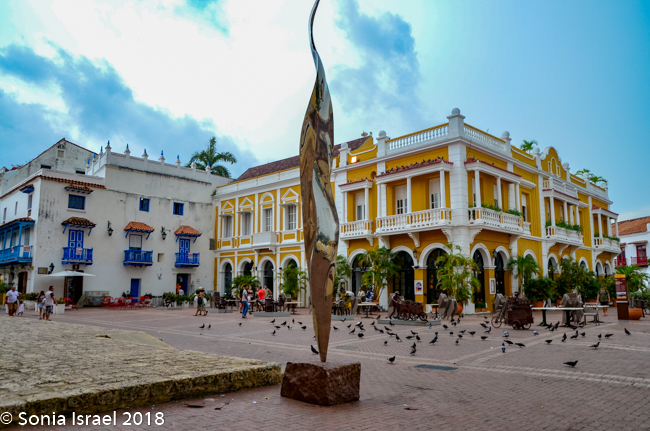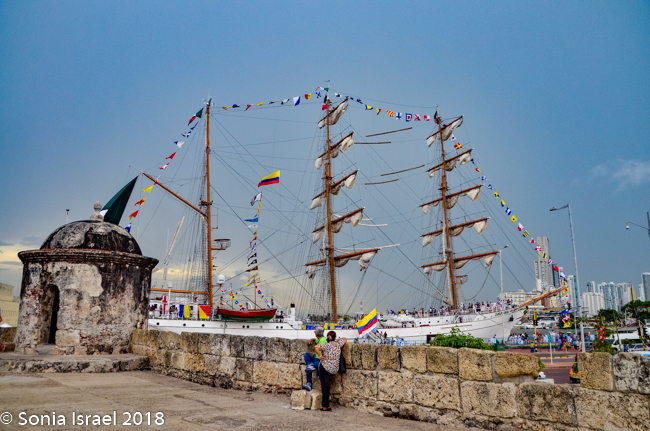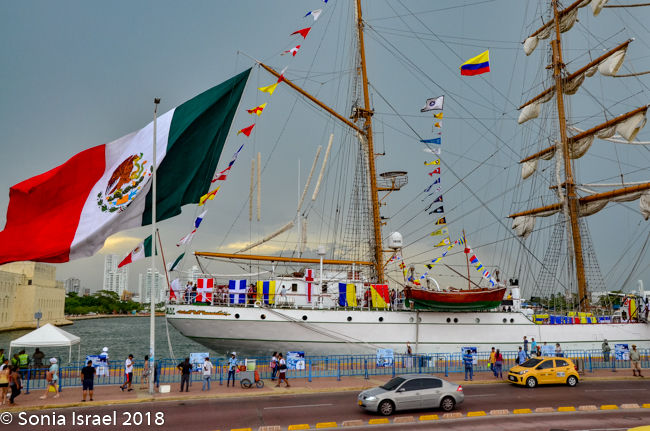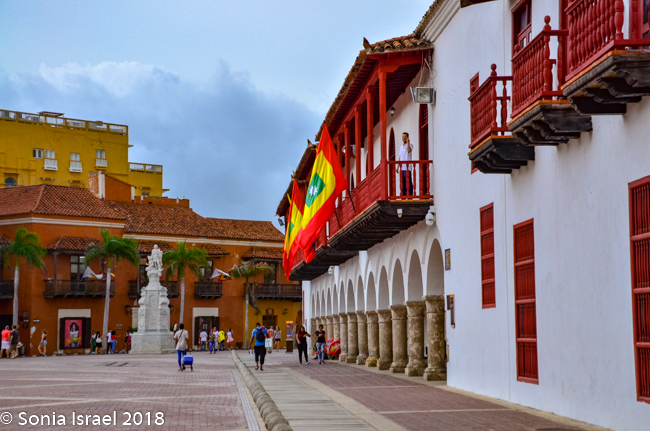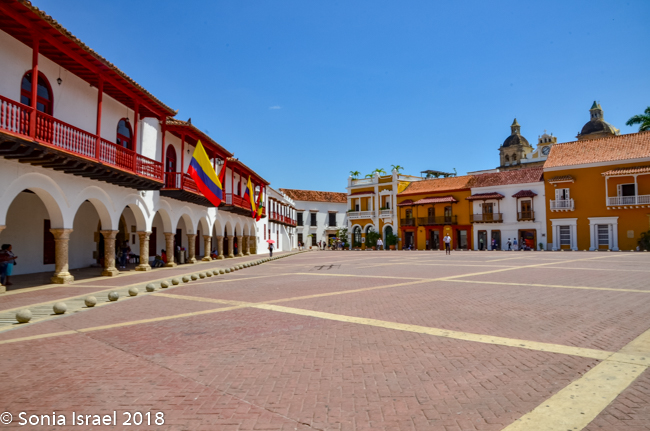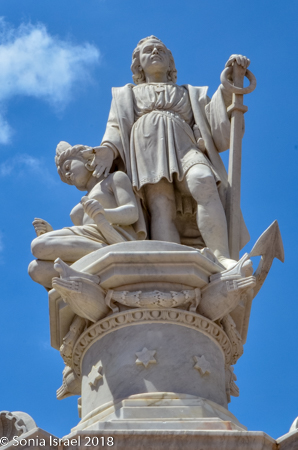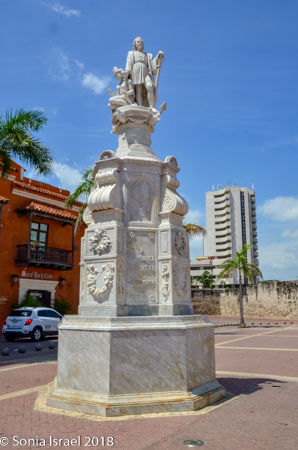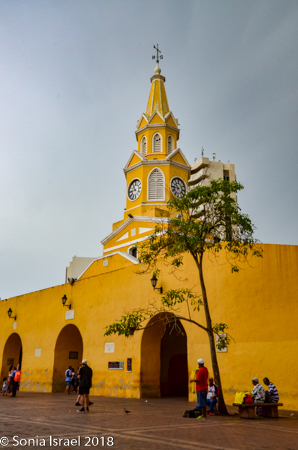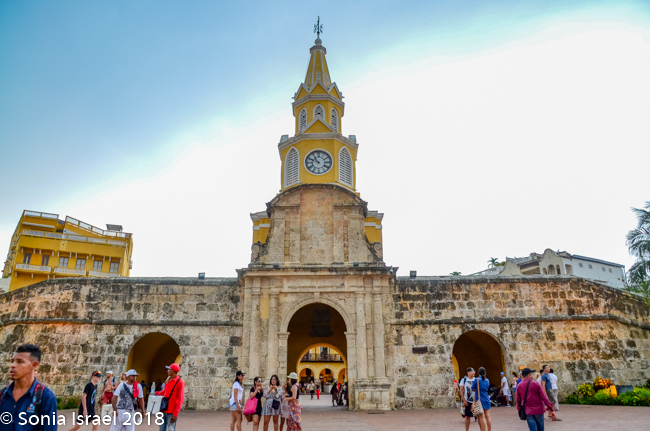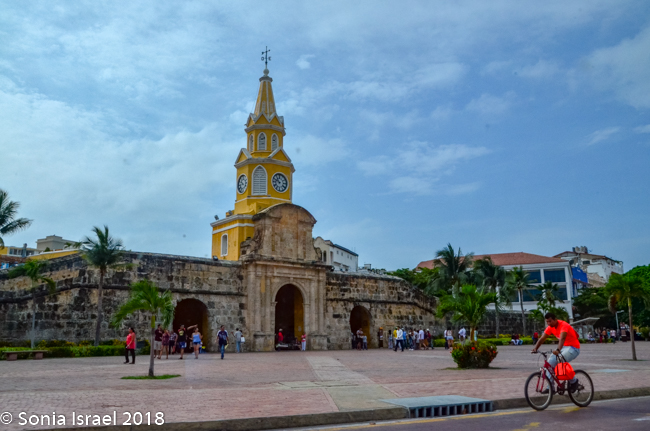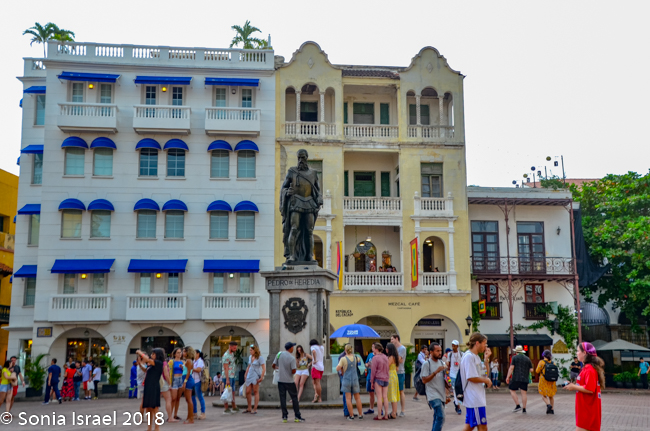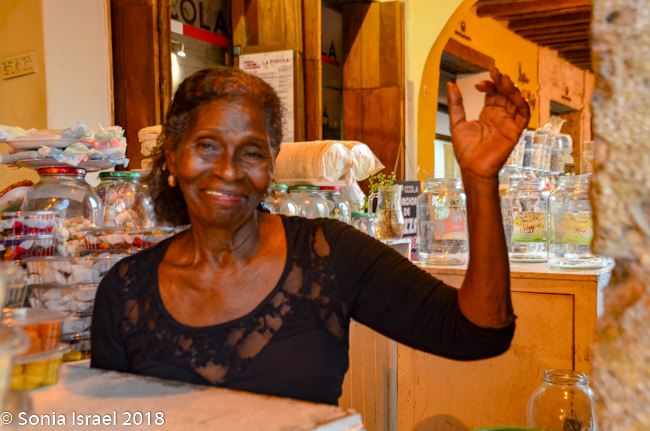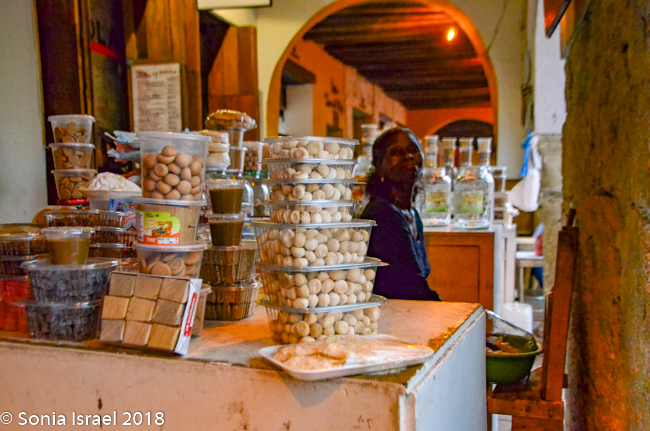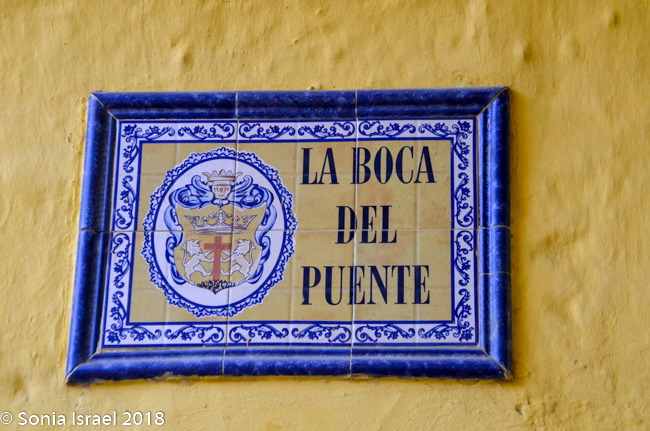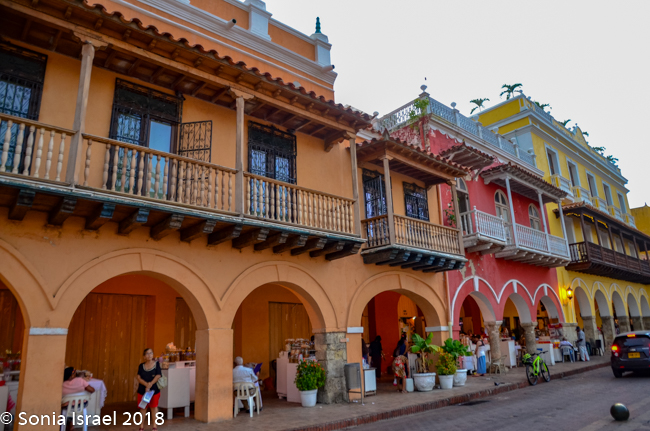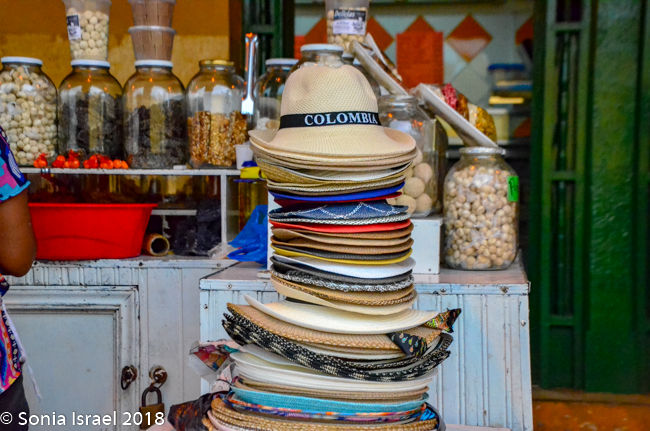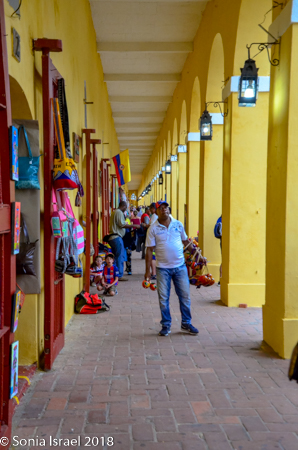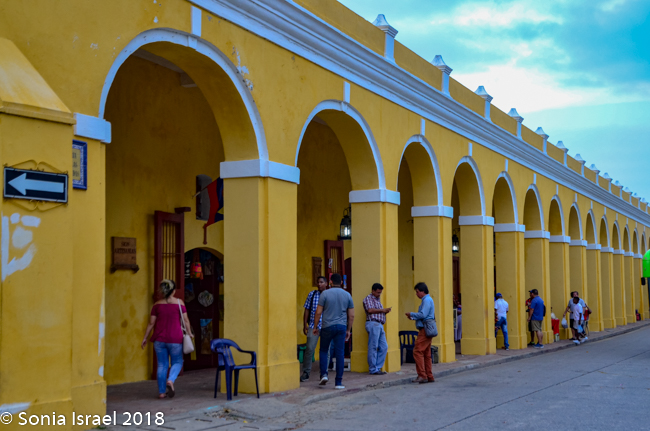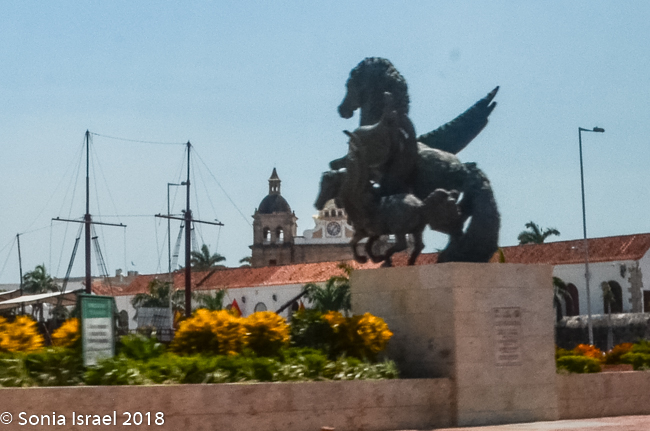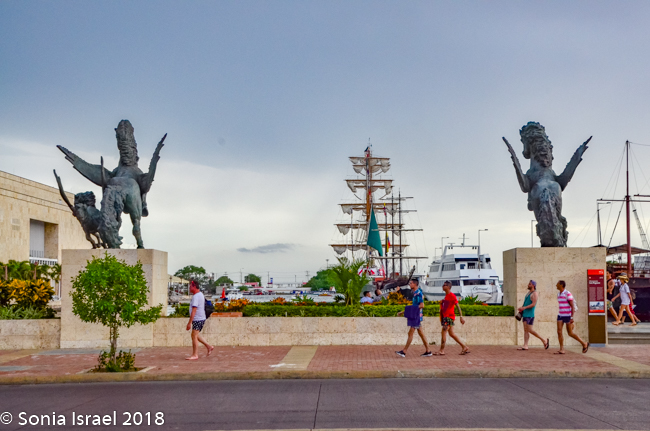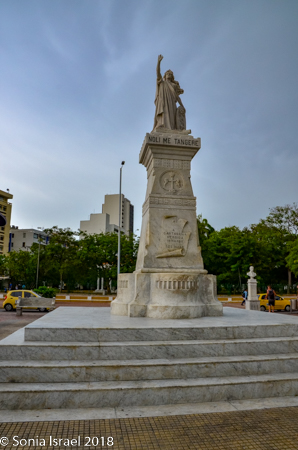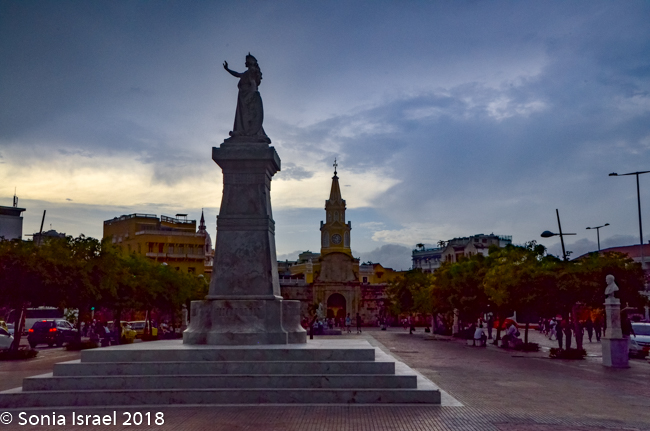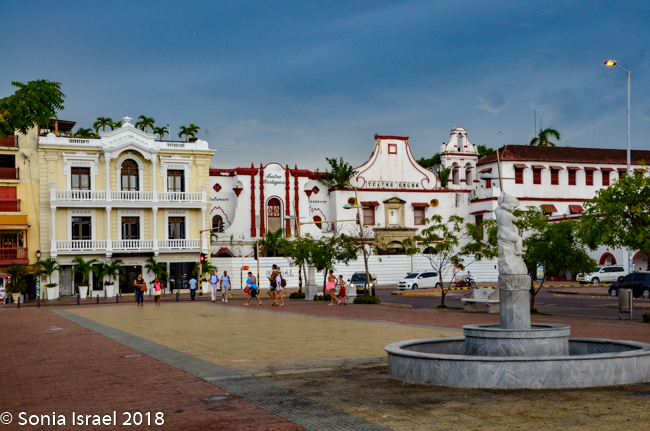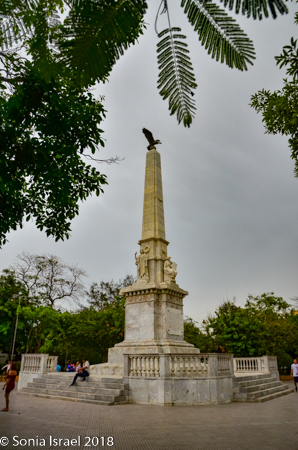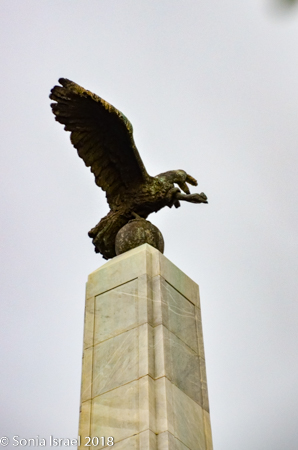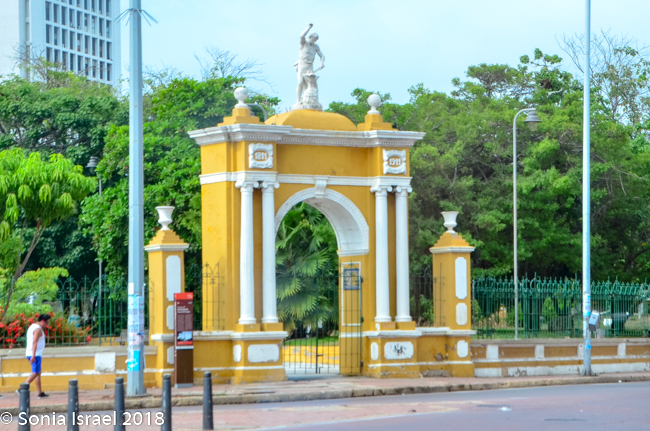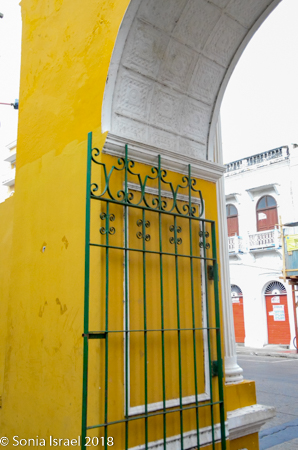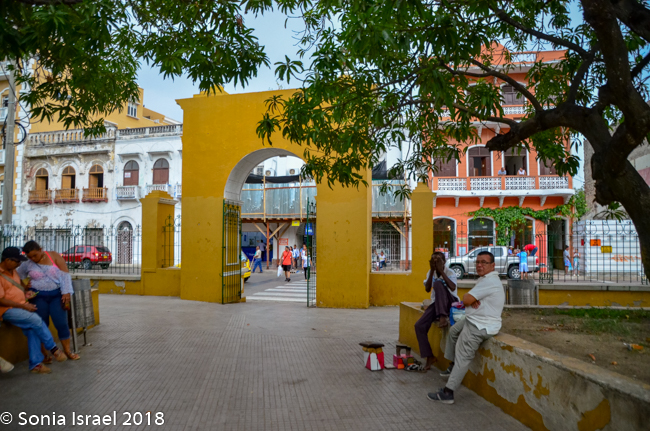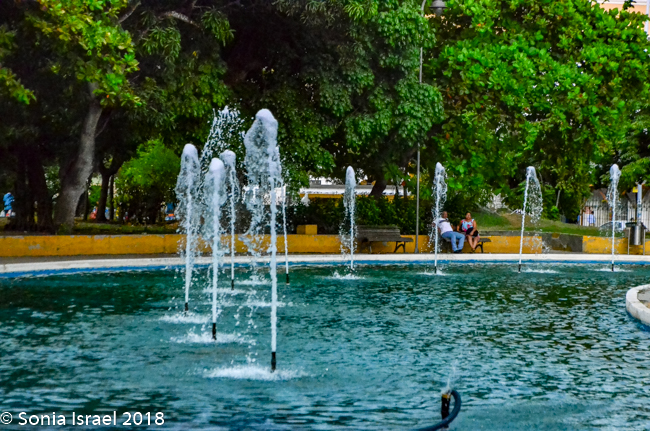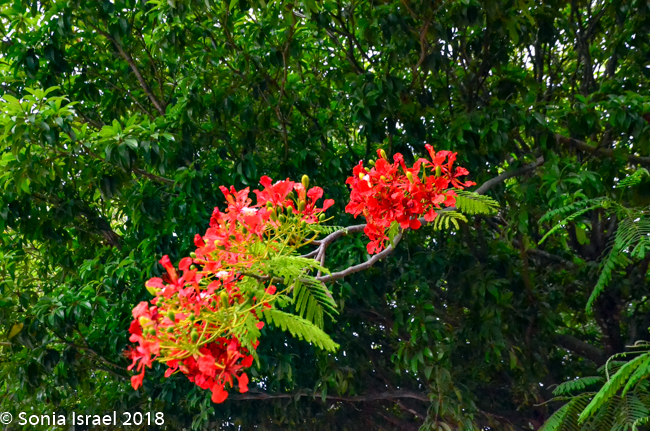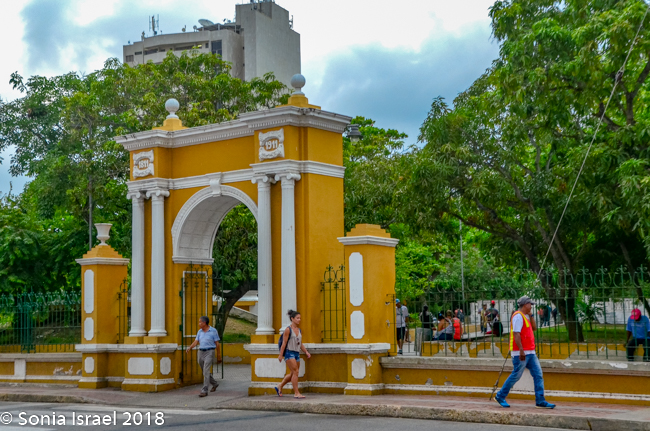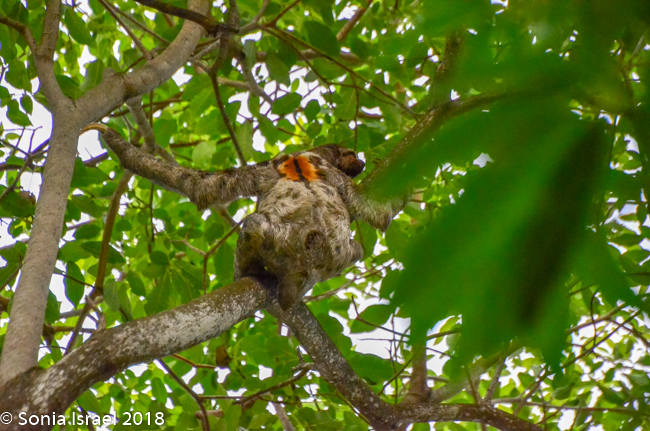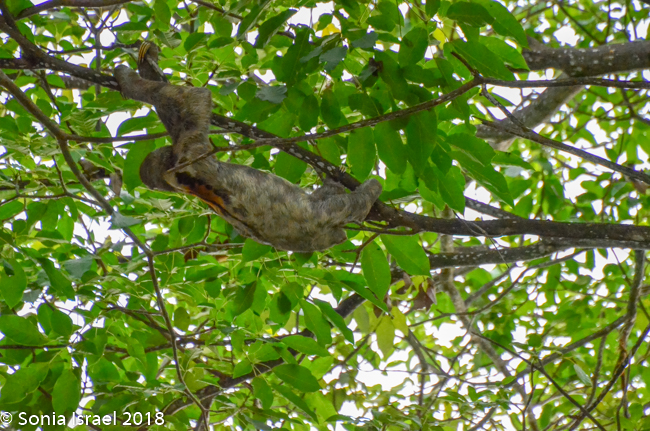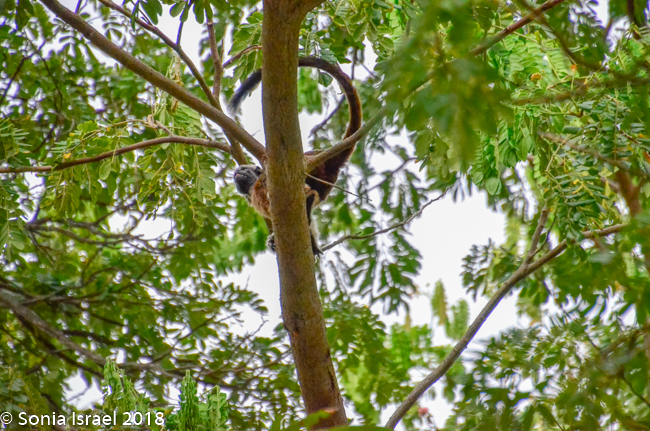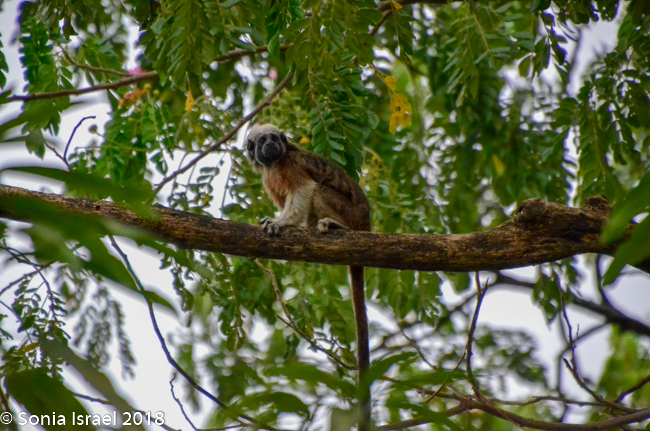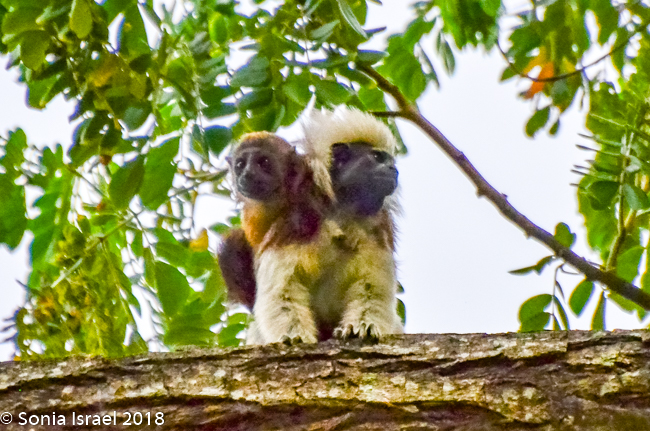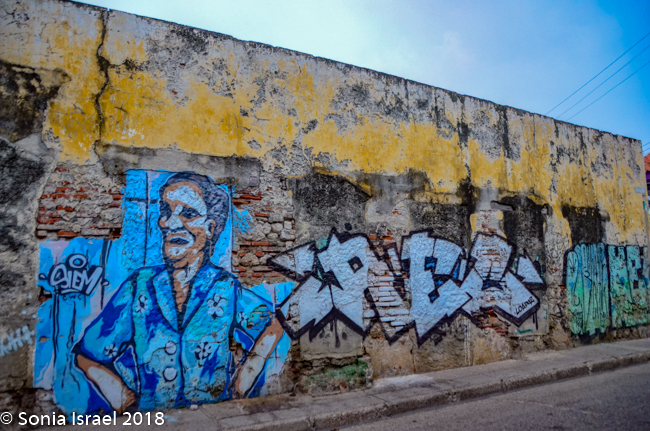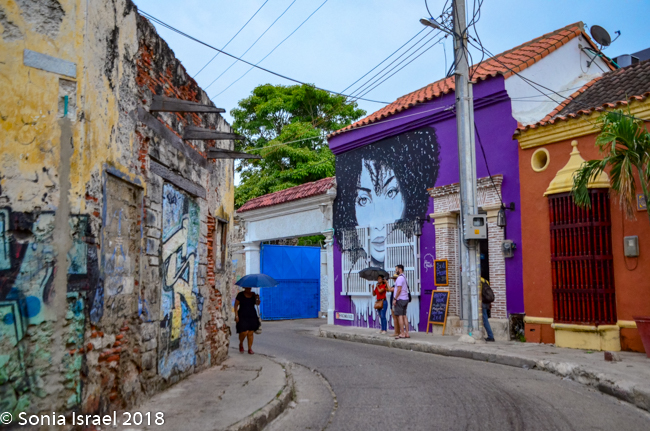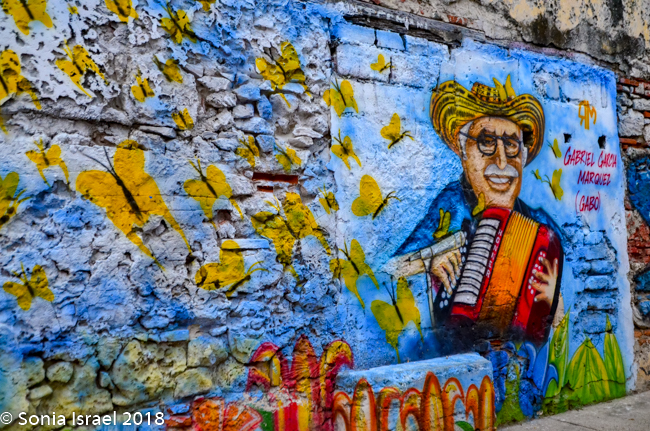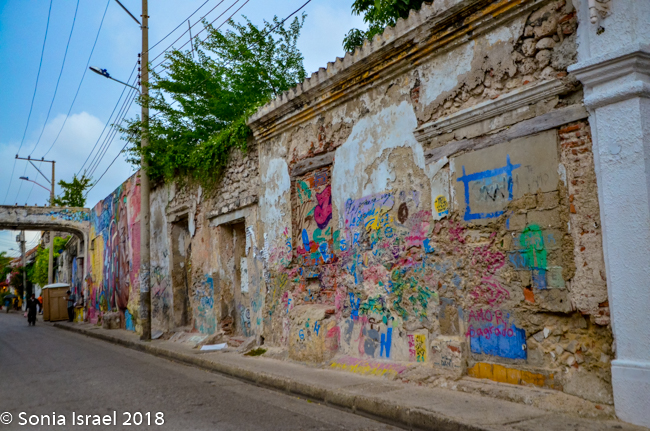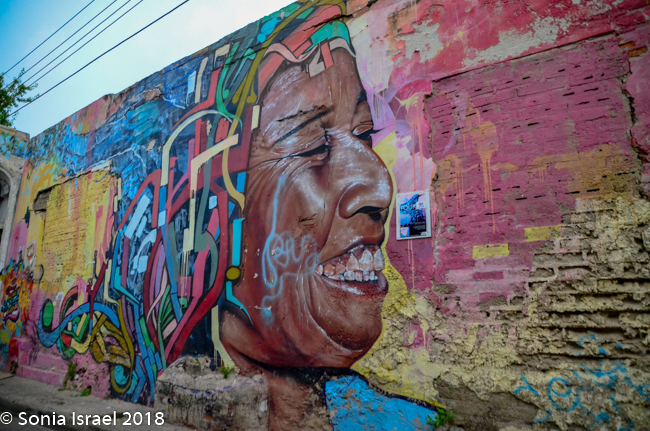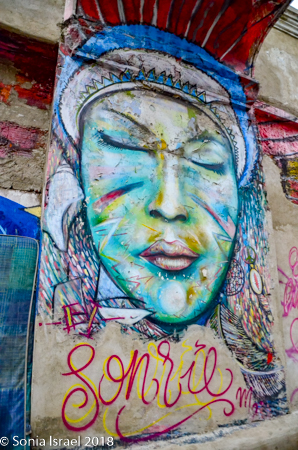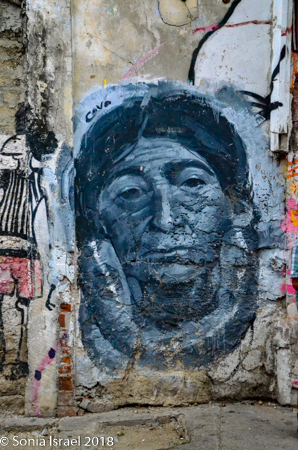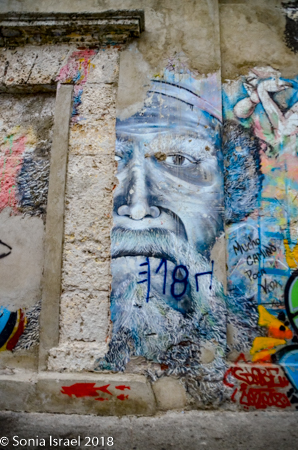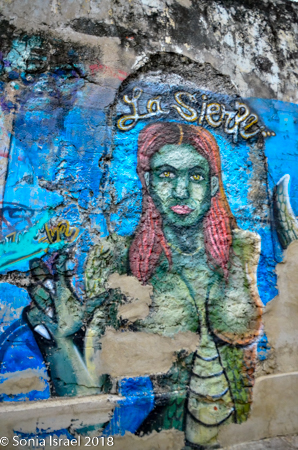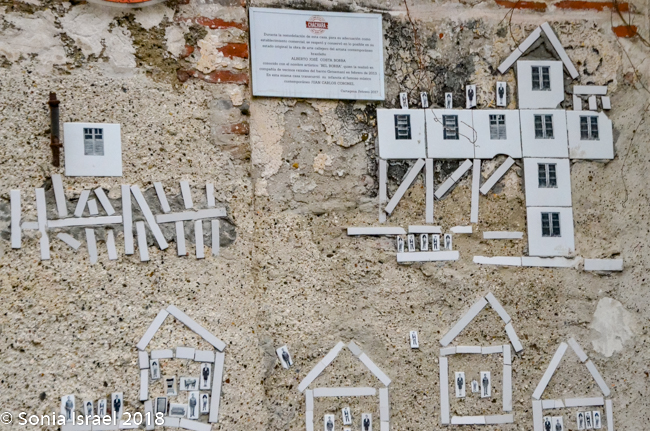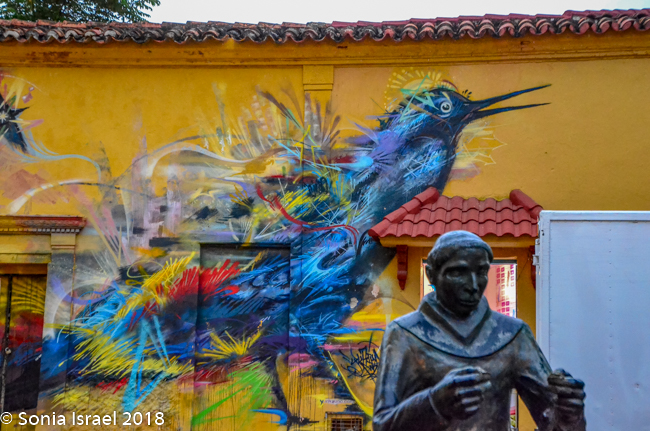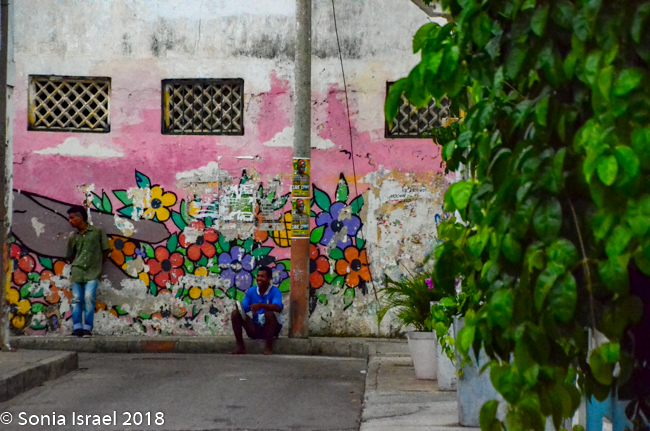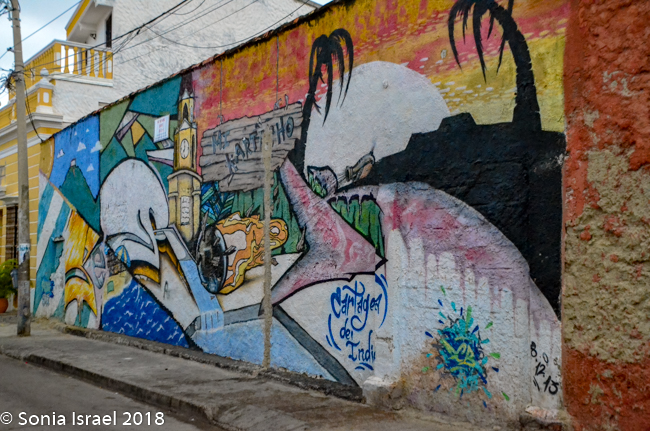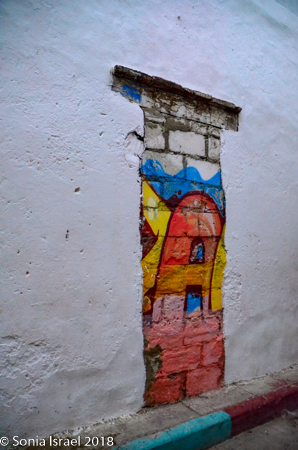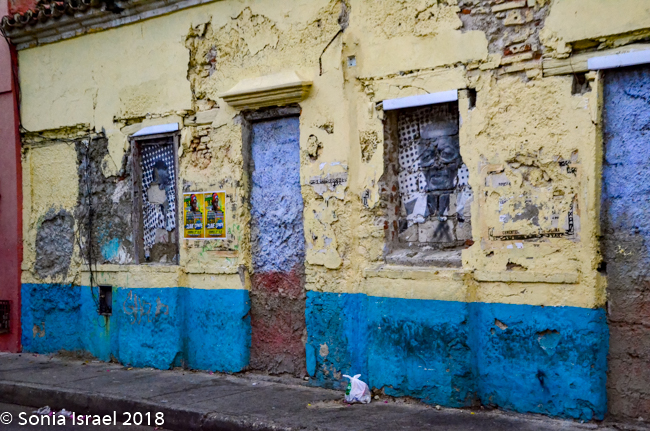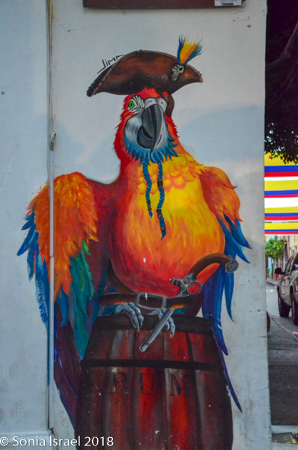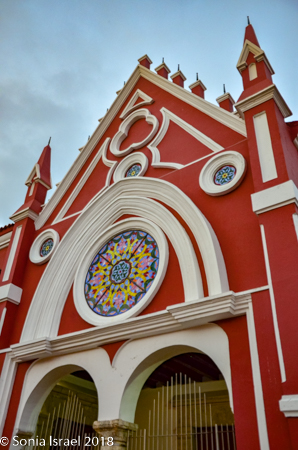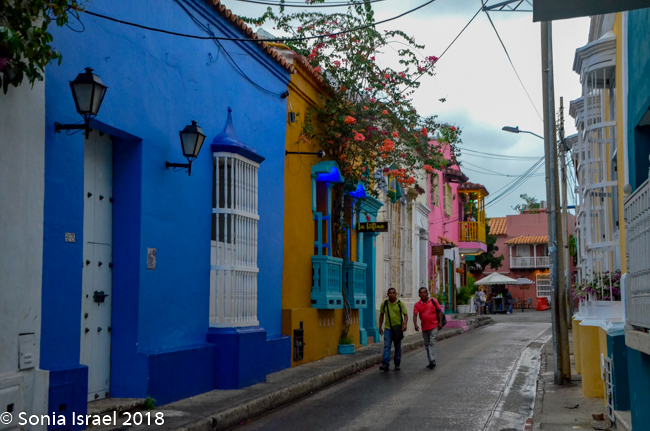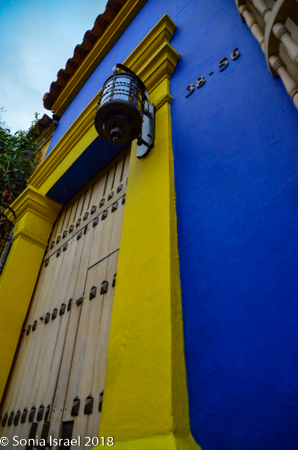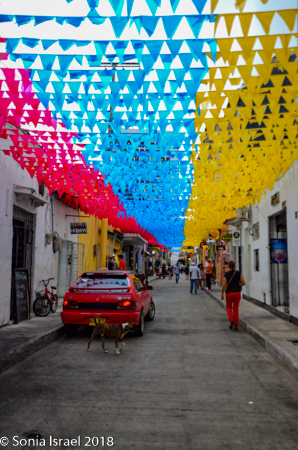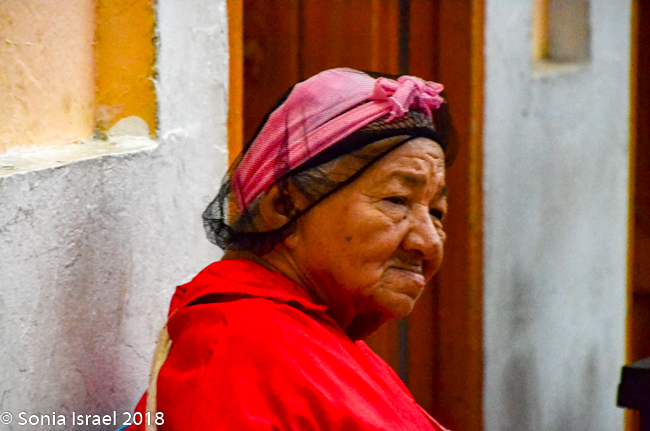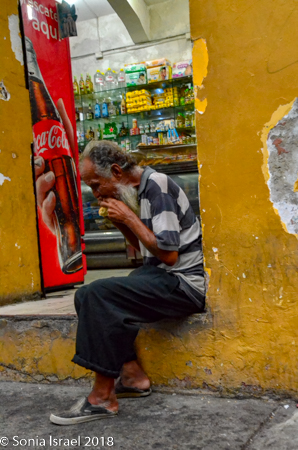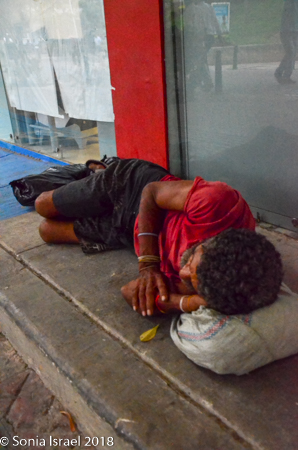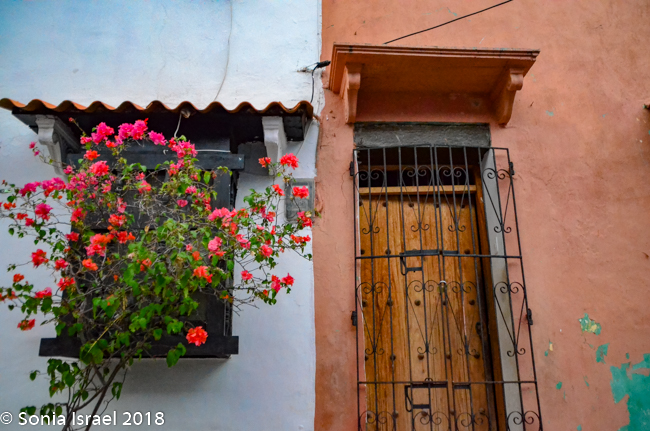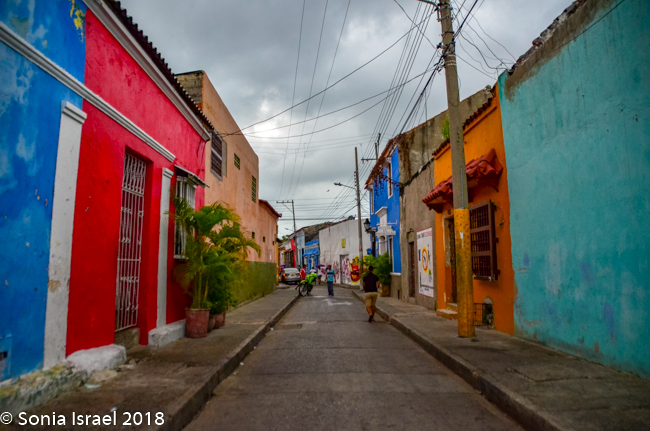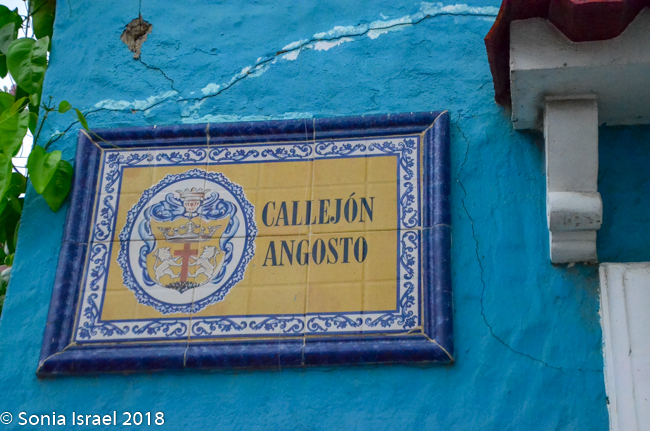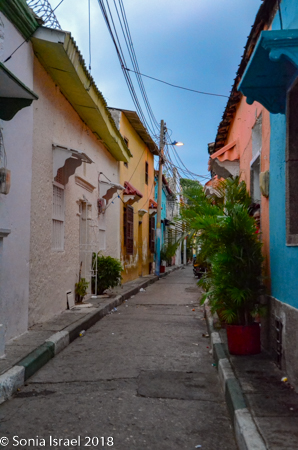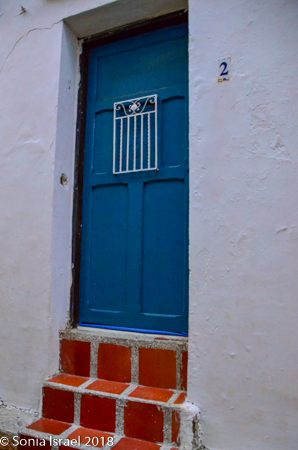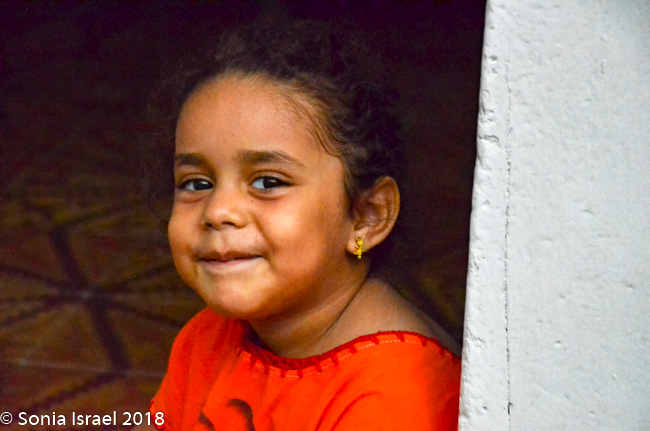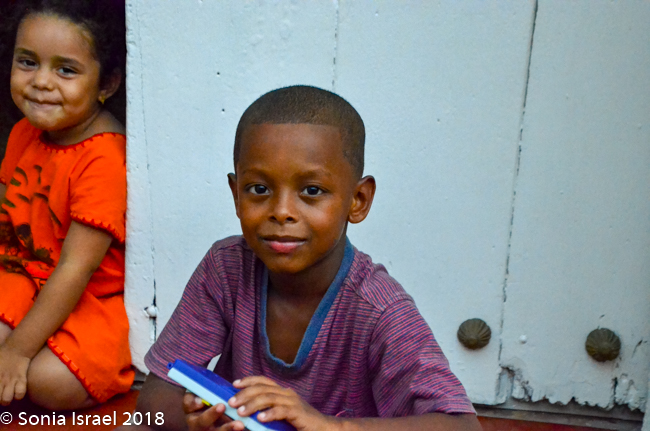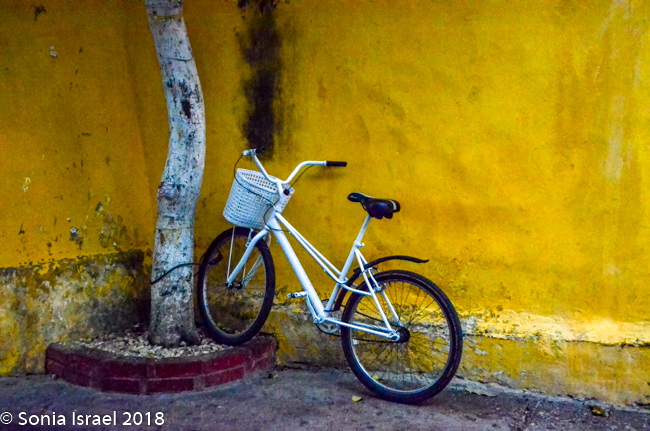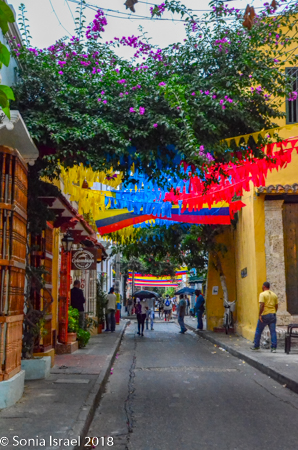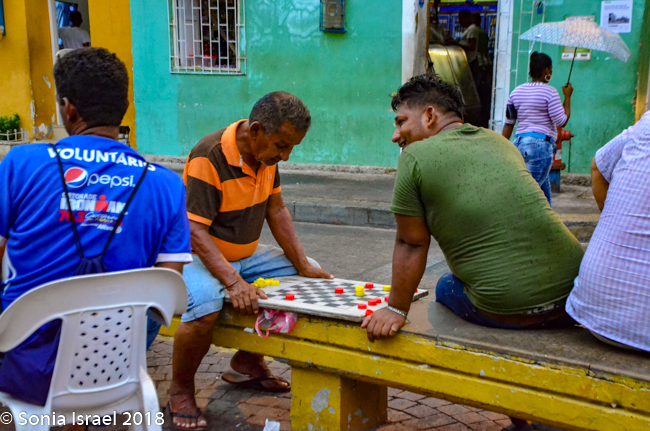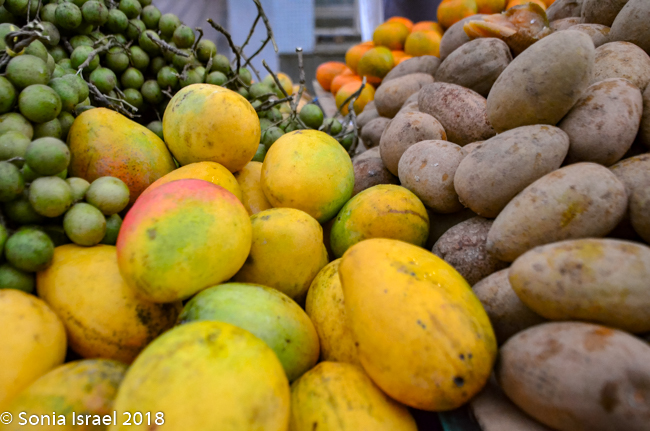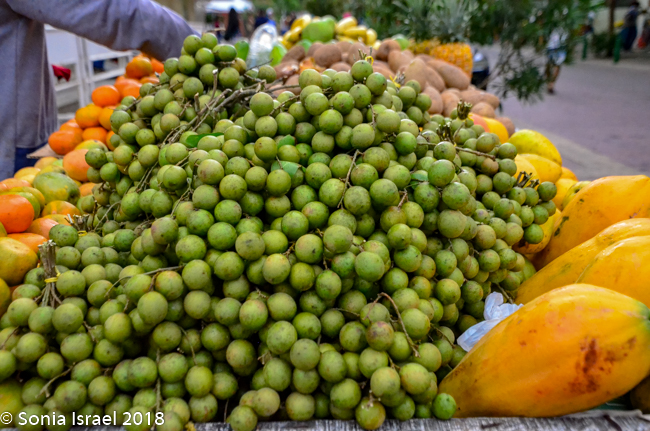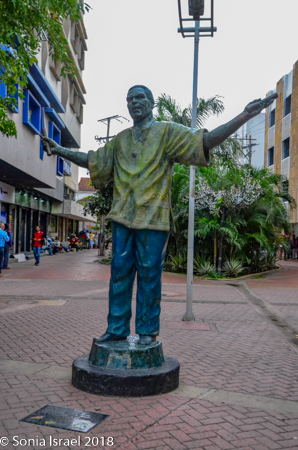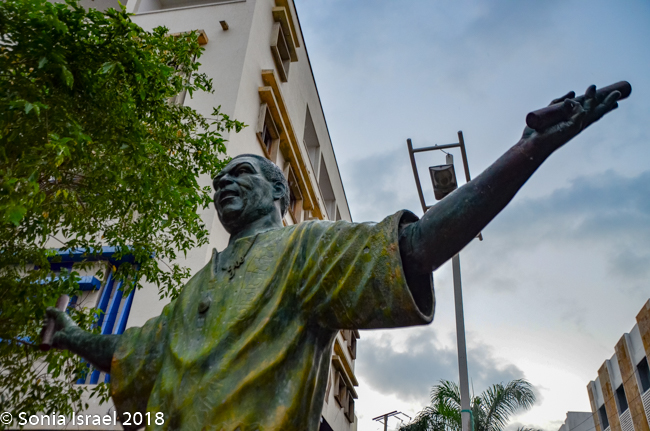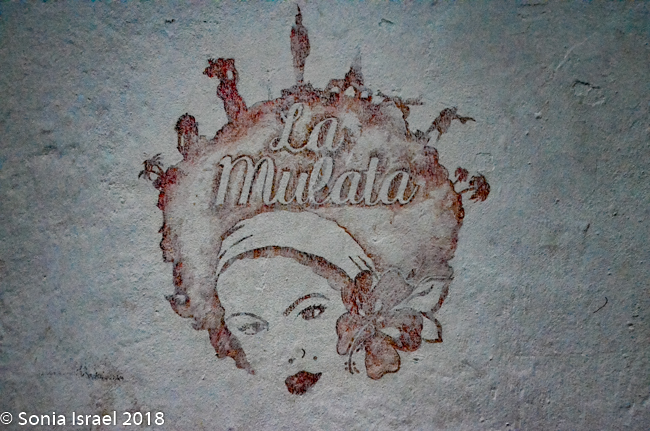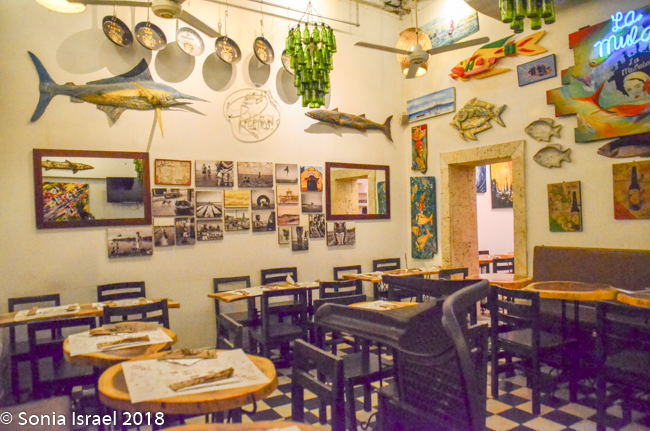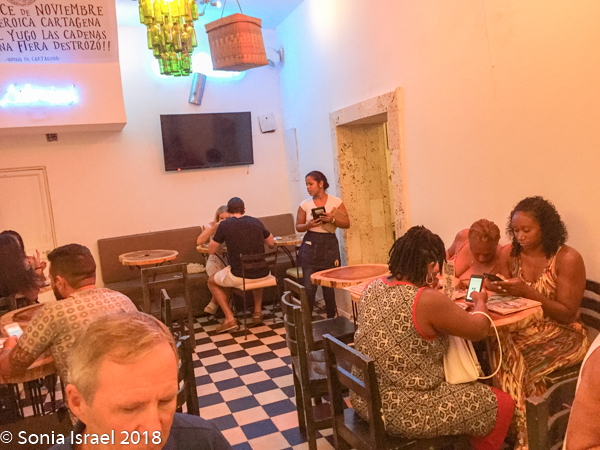July 23, 2018, Monday
Colombia
Unexpectedly, we had to cancel a trip in May and felt robbed. So we decided to plan another trip. June wasn’t a possibility, so that left July. Where to go in July? It’s summer which means most places, like in Europe or Asia, are crowded and hot. Ah, how about South America? How about Colombia? A place we had not yet been to. So, at the last minute, we made our plans and went.
We were flying into Cartagena and decided the most convenient way to do it was break up the trip by flying to Miami, staying overnight at the Miami International Airport Hotel, and then flying into Cartagena early on Monday morning. And that is exactly what we did. Now, this is not a blog about Miami, but I have to say that the airport hotel was amazingly convenient. We landed at terminal D, walked over to E, door 11 and found the check-in desk. We didn’t even have to leave the airport. The hotel elevator was also right there and took us up to our floor. This is one of the most convenient airport hotels I’ve ever stayed at. The room was basic, but sufficient and clean. They were outlets on one side of the bed (my requirement of every hotel). We overlooked the airport and watched a pretty sun set over the planes. We went up to the seventh floor to the Viena restaurant which also overlooked the airport. I had the Caesar salad which was overdressed. My husband had the Asian salad with chicken which was perfect. But the best part really is the convenience as the next morning we didn’t have to get up early to make it to the airport. We were already there.
The flight to Cartagena, surprisingly was a rather small plane with only two rows of first-class seats. But for the daytime flight, that was OK. It was a relatively short flight and as we began our decent we could enjoy the view of the Caribbean Ocean and the farm land below.
A Brief History of Cartagena
Let’s start with some background on Cartagena. It was inhabited by the indigenous peoples of the Karib, Malibu and Arawak, as far back as 4000 BCE. Because of it location on the Caribbean and therefore the perfect location for a port, it was often invaded by pirates. The Spaniards took over in 1953 and named it Cartagena after Cartagena, Spain which was named after Carthage, Tunisia. To differentiate it from the others, it is often called Cartagena de Indias. As the key port between Spain and its overseas empire, it was used for the export of silver and for the import of African slaves. This will come back again later in the story.
The Spaniards were not the only ones interested in Cartagena. In 1586, the English, led by Sir Francis Drake, a private pirate (privateer), attacked with 23 ships and 3000 men. They captured it in less than a day and their occupation lasted over two months while Drake negotiated with city officials for a proper ransom. And also while he looted the city. To motivate the Spaniard officials, he burned over 200 buildings and fired cannon into the city. In the end he won, being paid 107,000 ducats (roughly $34 million US Dollars) to free the city. He left just two days ahead of a Spanish fleet dispatched from Seville to trap him.
There is another interesting story about Sir Francis Drake and Cartagena. He and his crew are credited with inventing the mojito. After the siege of Cartagena, several of Sir Francis Drake’s crew fell ill. He sent envoys to Cuba to speak with the native peoples about a cure. His men came back with a drink made from a primitive form of rum, lime juice, and mint! Ah, a mojito.
After the debacle with the English and Sir Francis Drake, the Spaniards built a fortress and walls all around the city, walls 65 feet thick and 8 miles long to try to keep other pirates and countries from attacking. They felt secure with their wall and fortress, so they had only a very small army. The French took advantage of that and attacked. Since the Spaniards knew their small army wasn’t enough, they sent the local slaves to fight the French. What did the slaves do? They basically told the French, ”Go for it!” So the Spaniards were defeated again and the French became the new conquerors. After about one month, cholera struck the French and they left. The British again attempted to take over, but they couldn’t get past the swamp or the wall. Most were killed. Their one general, Edward Vernon, escaped to the US and later helped the United States win our independence.
Arriving in Cartagena
We walked down the steps of the plane and were immediately hit by the hot, hot, hot, stifling air. It felt and smelled just like the Caribbean. The smell of the sea. The feeling of the sun. Then we walked into the airport building and froze.
We were first off the plane so there was no line for passport control. Nevertheless, we had to zigzag through the ropes to get to the front. They never thought of a short-cut? I guess they were waiting for big crowds. Once we passed passport control, there was a long line to get out of customs. We finally made it to the front (we had carried on our bags so no need to wait for them), the guard checked our papers and sent us on our way. Others had to have their bags x-rayed. I guess we looked like we were safe.
The Turquoise Sky and the Turquoise Sea
 We were met at the airport by Vicky Olivo, our guide for the next three days, and Jose, our driver. We walked out of the air-conditioned airport building back into the heat. We immediately felt like we were in the Caribbean. We drove along the sea and were welcomed by a large, colorful sign, CARTEGENA, with a woman in a red bathing suit and short shorts standing in front of it, under the turquoise sky, posing for a picture. There were colorful cabanas all along the shore. And that should have been a clue that the best word to describe Colombia is colorful.
We were met at the airport by Vicky Olivo, our guide for the next three days, and Jose, our driver. We walked out of the air-conditioned airport building back into the heat. We immediately felt like we were in the Caribbean. We drove along the sea and were welcomed by a large, colorful sign, CARTEGENA, with a woman in a red bathing suit and short shorts standing in front of it, under the turquoise sky, posing for a picture. There were colorful cabanas all along the shore. And that should have been a clue that the best word to describe Colombia is colorful.
The Old Walled City – Old Town
We drove along the walls of the old city, and then entered through a narrow passage, just large enough for the car. Cartagena’s old city is surrounded by this old city wall and it is here that most tourists stay as it is the safest place in town. And perhaps the only really safe place in town. Vicky immediately warned us to stay within the walled city. We could freely walk around here both during the day and at night. But, don’t venture outside the walls, especially not at night. Point well taken.
And that was really OK, because the old city of Cartagena is where the action and the history are, full of colonial architecture, churches, monasteries, plazas, palaces and old mansions.
Our Hotel, the Ananda Boutique
We drove through the narrow streets to our hotel to drop off our luggage before beginning our tour of the Old City. We stopped in front of two massive wood doors, with a smaller door imbedded in the larger one. This was our hotel, the Ananda Boutique Hotel.
The hotel was beautiful with not only wooden doors, but lots of wood inside. There was an entry way with a side room filled with a large wooden desk where we checked in. We were immediately served two glasses of cold corozo juice, a  traditional Colombian drink. Corozo is a small, reddish-purple fruit grown high on the palms on the coast of Colombia. This small, berry-type fruit is very sweet and so is boiled with water to make juice (as well as jelly, jam or ice cream). The juice, like the berry, was a beautiful purple-red color and tasted sort of sweet and a bit sour all at the same time.
traditional Colombian drink. Corozo is a small, reddish-purple fruit grown high on the palms on the coast of Colombia. This small, berry-type fruit is very sweet and so is boiled with water to make juice (as well as jelly, jam or ice cream). The juice, like the berry, was a beautiful purple-red color and tasted sort of sweet and a bit sour all at the same time.
Right inside the entry was a large courtyard with water features and tables for breakfast, lunch and dinner when it wasn’t too hot or raining. We never did eat outside because it was, in fact, too hot. And just on the other side of the courtyard was a small swimming pool.
And on the roof was a second small pool and a great view of the city. I went up there one night to watch the sun set. Gorgeous!
We took the small elevator up to our floor. The elevator was all glass which allowed us to see the old red brick walls which now made up the elevator shaft. Once off the elevator, there was a walkway along the balcony overlooking the courtyard. But our room was around the corner, overlooking the swimming pool.
The room was large and decorated with antiques and Colombian art. Quite beautiful.
But all we had time for was to drop the bags, do a quick change of clothing, grab hats and head back out again. Vicky was waiting for us in the lobby and off we went. First stop. Coffee!
A Reason for Every Name
We started walking around the Old Town. We would read the names of the streets, trying to learn our way around and to get oriented. Vicky told us that there is a reason for every street name. Back in the colonial times all the streets of the city had Catholic names as a way to impose the religion. After independence, the people removed the Catholic names and named the streets in honor of the heroes of the independence or important people. “Or even to remember part of our history.” For example, one street is named Calle de la Amargura (the Bitterness Street). Why? ” There were two men who were taken by the inquisition. One said to the other, “Oh my friend, this should be the bitterness street since it is the last we walk on before we die.” And so it is called.
Colombian Coffee
People were everywhere, both locals and tourists. We saw many men and women carrying what looked like a large thermos and a stack of small white plastic cups. Coffee. Colombian coffee. Vicky bought us a cup and our taste buds experienced our first taste of tinto.
Tinto
A “tinto” is the Colombian way to say “welcome.” Tinto is the most common preparation of coffee in Colombia and simply means a long black coffee. Originally, the word ‘tinto’ came from a working class joke. The people who could not afford to drink red wine (‘vino tinto’ in Spanish) would instead drink coffee.
We were in fact on our way to a coffee house, but this was a must to try. I am usually a ‘cream and sugar in my coffee’ type of gal, but this was black and unsweetened, and delicious. I could get used to this.
We continued walking over to San Alberto, which calls itself “A temple for Colombia’s most award-winning coffee.” And it is here, sitting over another cup of coffee, Vicky explained something about the Colombian coffee industry. (For the full coffee story, please see the post on Jardin.)
The connection between coffee trees and sinning
Your first question should be, “How did coffee trees get so popular in Colombia?” It was all because of a priest. Colombia is a Catholic country. When Catholics sin, they have to ask for forgiveness and then pray. But then they would sin again. So the priest told them to plant a coffee tree for each sin. Suddenly there were lots and lots of coffee trees. The best coffee is exported. But during the years of the drug wars, even that stopped (please see the post on Medellin for the story of the drug wars).
Juan Valdez
What about Juan Valdez? We all remember the Juan Valdez magazine ads and TV commercials. A good-looking coffee farmer, Juan, would pick the beans off the bushes and that coffee would make its way to us. So who was Juan Valdez? And was there really a Juan Valdez? Sorry, no. He was a fictional character, sort of. The Colombian government needed a way to promote their coffee to the rest of the world. Juan Valdez was the name of the family who grew the most coffee, so their name was used to promote coffee in general. But it was just a name with no face. So  the Colombian government advertised for a model, that is, for a face to represent the coffee. They found the perfect face, but it was on a Cuban man. The Colombians complained. “A Colombian should represent our coffee.” So they advertised again and found a Colombian. And he became the famous face of Juan Valdez. There are as many Juan Valdez coffee houses in Colombia as there are Starbucks all over America. But there are also smaller coffee houses, like San Alberto, who many believe have better coffee.
the Colombian government advertised for a model, that is, for a face to represent the coffee. They found the perfect face, but it was on a Cuban man. The Colombians complained. “A Colombian should represent our coffee.” So they advertised again and found a Colombian. And he became the famous face of Juan Valdez. There are as many Juan Valdez coffee houses in Colombia as there are Starbucks all over America. But there are also smaller coffee houses, like San Alberto, who many believe have better coffee.
Vicky told us that since the coffee came from so many farms, they couldn’t control the quality. San Alberto controls their coffee because they only use coffee from their own farms. Most coffee farmers however belong to a coffee federation. We learned much more about this when we visited a coffee farm in Medellin (please see that post). But for Cartagena, San Alberto is the best coffee.
The Color of Old Town
We walked through narrow, curvy, irregularly shaped cobblestone streets lined with colorful colonial houses standing 3 or 4 stories with balconies and flowers. Blue doors on white houses. Purple with yellow. Orange. Red. And often more than one color on each house. Color, color, color. This is the historic center of the city, the walled enclosure.
Doors and Door Knockers
Just like at our hotel, almost every home had a very large door with a little one in it. This was very traditional in the olden days and most of the old homes still have these types of doors. The smaller doors were for the servants and for deliveries. The large doors were for the rich, both for them and for their horses. Every door had buttons on it. Large buttons for the rich. Small buttons for the poor. This is all left over from the Colonial Spanish days.
Each door had an elaborate knocker on it, called aldabas. This started out as a Spanish colonial tradition. The Spaniards were fond of saying, “A tal casa tal aldaba,” (“To each house its door knocker.”) Today these are ornamental but once they symbolized the family’s social status and wealth. And whatever the knocker was, represented the person’s profession or occupation. A fish on the door? A fisherman lived there. A lion? A member of the army or a protector of the city. A mermaid? A merchant. A lizard? Royalty. Hands? A clergy member.
The Walls of Cartagena
We were on our way to visit the city walls. The walls were built to defend the city from pirate attacks, although it took two centuries to build them. There are now seven miles of walls, all of imposing large stones with pieces of coral in them and with fortifications and bastions. We stopped to read the signs along the wall telling some of the history, and Vicky filled in the details. The walled city is a UNESCO World Heritage site. We opted not to walk the walls, but rather walk the city.
Vicky pointed out old, beautiful Colonial buildings that were once monasteries but now were schools. There seemed to be lots of those.
We passed the Casa Drake, an orange home with purple doors and flowers hanging down.
I mentioned that Sir Francis Drake once attacked Cartagena, but he then also lived here. In fact, he attacked the Cathedral of Cartagena, our next stop.
As part of Drake’s threat for a ransom, he threatened to demolish the cathedral, the most precious building in the city. He made the first warning shot, which was enough to seriously affect its structure, as the bullet struck one of the columns, knocking it down and taking two more with it. The arches that supported the three columns and part of the ceiling all fell. That is when the Carthaginians’ paid the ransom.
Cathedral of Cartagena
The Cathedral of Cartagena is an imposing building that can be seen from almost everywhere in the old city as it is so tall. Inside it has a wooden beamed ceiling and marble columns with a gilded altar. It was relatively small compared to many churches we have seen around the world, and because of that it seemed more intimate, less intimidating. I imagined that those that came to pray here would feel great comfort.
The Cathedral is officially called the Metropolitan Cathedral Basilica of Saint Catherine of Alexandria. It is an episcopal church and one of the oldest in the Americas. The design was modeled after the basilica in Andalusia and the Canary Islands.
Eat Fruit
We continued on our walking tour of the Old Town. We walked through the narrow streets filled with vendors. At times it seemed like there were more vendors than tourists. And, along with the usual souvenirs, they were selling lots of fruit. Fresh whole fruit. Cut fruit. Fruit by the pound. That fruit was for sale.
The Palenqueras
But then there were the Palenqueras, black women dressed in traditional colorful dresses, balancing bowls of tropical fruit on their heads. They used to sell fruit, and some still do, but mostly today they make their money posing for pictures. If you wanted a picture of them, you had to pay. I was able to get many pictures of them from farther away, and I rarely pay for pictures. But this was one of those times when it was very worth it. I picked an older woman, one with an interesting face full of time and age and stories. She gave me a wide smile. My favorite part of shooting pictures of people is when they smile at me. Who are these women? Where did they come from? And how exactly have they become the symbol of not just Cartagena, but of Colombia? That is the story of Palenque. This woman was from Palenque, a small town we would be visiting the next day and it is the story of Palenque that explains the story of these women (please see that post).
Love is in the Air
We kept walking some more, this time toward the Plaza Bolivar. And on that plaza was the first mailbox in Cartagena. Significant? Well, if you hear the story, you will understand why that answer is yes. It is a sad story. A story about love. Many, many years ago, workers came from Italy to build marble churches. After all, who better to build with marble than the Italians? One such Italian laborer fell in love with a local girl. But her family would not accept him. He returned to Italy with a promise that h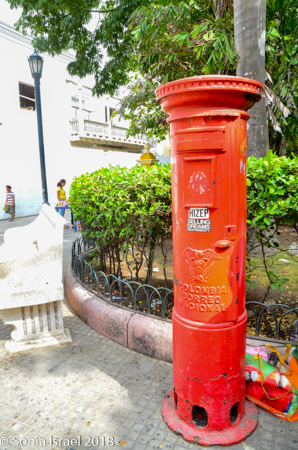 e would make enough money to come back. And she waited for him. He regularly sent love letters to her. One day, he sent her money to come to Italy so they could be reunited. But, although the old red mailbox was still there, it was no longer used as there was a brand new one. The sailor, not aware of the new one, put the letter in the old red mailbox. So she never got the letter. And they never saw each other again.
e would make enough money to come back. And she waited for him. He regularly sent love letters to her. One day, he sent her money to come to Italy so they could be reunited. But, although the old red mailbox was still there, it was no longer used as there was a brand new one. The sailor, not aware of the new one, put the letter in the old red mailbox. So she never got the letter. And they never saw each other again.
The Sweetness of Nothing
The Bolivar Plaza is also known as the Park of Bolivar (Parque de Bolivar). It is an urban, shady park emblematic of the city, full of historical and cultural symbolism. The square was filled with people just sitting and enjoyin g the day. Vicky called it the “sweetness of nothing.” The opportunity to just sit and think. How refreshing. Just sitting and thinking and not having a phone in your hand feeling the urge to check every few moments. The sweetness of nothing. I loved that.
g the day. Vicky called it the “sweetness of nothing.” The opportunity to just sit and think. How refreshing. Just sitting and thinking and not having a phone in your hand feeling the urge to check every few moments. The sweetness of nothing. I loved that.
Plaza de Bolivar
In the center of the plaza, with all the people sitting around it, was the statue of the liberator of Cartagena sitting atop a horse waving his hat to his admirers, their leader of independence, Simon Jose Antonio de la Santisima Trinidad Bolivar Palacios Ponte y Blanco, more generally known as Simon Bolivar or El Libertador.
But the square also has lots of its own history. It was originally called the church square, later as Plaza Mayor, where the great military acts of the time were held, but in 1610 it became the Plaza de la Inquisicion, the inquisition. There is lots of history around the inquisition in Cartagena, and that would be our next stop.
But in 1896 the equestrian statue of El Libertador Simón Bolívar was installed and since then it has been called “Plaza de Bolívar”. Bolivar was a Venezuelan military and political leader who liberated from Spain what is now Venezuela, Boliva, Colombia, Ecuador, Peru and Panama. He is the national icon of most of modern South America and is considered one of the heroes of the Hispanic independence movement of the early 19th century.
Historical Museum of Cartagena
We walked through the square to the other side to the Historical Museum of Cartagena. The Historical Museum of Cartagena is really a museum about the Inquisition and its presence in Cartagena. But it is also about the Karibe Indians, inquisitors and witches, the conquistadors, and pirates. The building itself was magnificent, with a large carved door and wood balconies overlooking the street. Pretty on the outside. But the story inside was far from pretty.
The sign at the entrance said is well:
“Jewish, witch, witch doctor, solicitor, are only a few of the terms used to denounce, judge and condemn those who strayed from Catholic faith. They were the others, considered different. Others uprooted from their lands, but who were able to bring with them their ancestral practices and knowledge. Others who arrived by different means and with different beliefs, all of whom were looked upon with the same lens, which condemned the different. Some of these terms have changed. Others remain as a sign of the fact that the practice of judging others still persists. Judging them because they think differently than we do, they have beliefs different than ours. And in that past and present judgment we forget about that other, who at some point could be ourselves. Let this be a space that allows us to comprehend and reconcile with the past of the city, and free ourselves from the inquisitorial practices which we presently use to approach one another.”
The Inquisition in Cartagena
The inquisition played a large role in shaping Cartagena.
My collective memory of the inquisition comes from reading history books and visiting Spain where the Jews and the Moors and homosexuals and anyone else who was not a Catholic or did not live by the Catholic rules was forced to convert or to flee, or worse, was tortured and burned. It was no different here. Between the history shown in the museum and Vicky’s stories, here is what we learned.
Since Cartagena was a center of commerce, a transit point between the Caribbean and Spanish settlements in western South America, the city became the third in the Spanish empire to have a tribunal of the Holy Office of the Inquisition, housed in the Palace of Inquisition. While the name, Court of the Holy Office, sounded innocent, the the Spanish Inquisition carried out its gruesome work until independence from Spain was won in 1812. The Palace was used by Inquisition to try Jews and other non-Catholics and about 800 individuals believed guilty of crimes such as black magic were tortured and publicly executed here. Vicky told us lots of stories about the inquisition. And we slowly and reverently read the stories in the exhibits and tried to imagine how those instruments of torture could actually be used on people.
Walking into the courtyard, the first building we saw was the secret prison called the House of Dungeons. Here, denounced heretics would await their judgement. Torture was used not as a punishment itself for heresy but to obtain a confession which the Inquisitors believed was necessary to bring the heretic back to faith. The Inquisition’s principal purpose was to defend and protect deemed threats to the Catholic Church, including blasphemy, witchcraft, and heresy. Once a confession was signed, the victim was sentenced to death in a public auto-da-fé in the courtyard outside.
Many of the grisly tools used to extract confessions were on display. The principal method of torture was the strappado, where the victim was tied with their hands behind their back and suspended in the air whilst a series of weights and drops were added. The other infamous torture method was the rack. Often just watching another victim being stretched on the rack was all it took to obtain a confession. We also saw thumb screws, the head crusher, and an iron collar covered in lethal spikes.
One of the largest groups targeted by the Inquisition in Cartagena were supposed witches. However the persecution of witches amounted to little more than the vilification of women through trials where victory for the accused was impossible. A notice on the wall of the museum lists the questions the accused faced, including “What evils have you caused and to whom?”; “What words do you pronounce when you fly?” In the over 800 trials which took place at the Palacio de la Inquisición, not a single person was ever found innocent. We walked through the museum, past the infamous witches’ ducking stool, and into the leafy courtyard beyond, where the Inquisitor’s guillotine still standing.
The last official victim put to death by the Inquisition was in 1834.
After spending time looking at instruments of torture, we needed a breath of fresh air. It felt good to feel the breeze on our faces, hear the laughter from the people all around us, although one can never, should never, purge the memory of the horror that took place here and everywhere else in the world.
Plaza Santo Domingo and Botero
Cartagena is also filled plazas. Places to sit and drink coffee and watch the world go by. One of the plazas had a large Botero statue, our first for this trip. I learned about Botero many years ago and always loved his sculptures. Botero was from Colombia and is therefore one of Colombia’s favorite sons. His statues are everywhere and we would get to see lots of them over the next ten days. Botero was from Medellin, and that is where I will write more about him (please see that post). For now, suffice it to say that his statues are like his name – round. The one in the square was one of his Mujer Reclinada (reclining woman), La Gorda Gertrudis, but the best part was the two young girls lounging against the “mama”, posing for a picture. Not posing for me, but I took the picture anyway. And of course, for a few pennies (actually for many dollars) you could buy a replica.
All around the Botero statue were charming metal sculptures of people doing what Colombian people do: getting a haircut, a man with a fruit cart, men playing chess, etc.. These were made by sculptor Eduardo Carmona.
Church of Santo Domingo
The Church of Santo Domingo stands here (thus the name of the plaza), with a slightly tilted tower. That’s because a few days before the church was finished, the devil came and tired, unsuccessfully, to topple the tower. Such wonderful legends.
Museum of San Pedro Claver
Now that our heads had cleared a bit, it was time for another museum, dedicated to the patron saint of slaves, inside the cloisters where he lived and died.
This felt more like a church than a museum. We walked into a beautiful garden with tall trees and arches and flowers. There were two large bells hanging there and it was sure tempting to ring them, but we refrained ourselves. Once inside we heard the loveliest voices singing. It was a Navy choir that was in port visiting. I was so enthralled watching and listening, that I didn’t think of making a video until they took a break. Then of course, it was too late.
San Pedro Claver was the first to be canonized in the New World. He dedicated his life to tending to the slaves literally from the instant they arrived in the Americas. In life, Claver became known as “Apostle of the Blacks” – or more derisively by his slavery-approving Jesuit brothers “Slave of the Slaves.” For 40 years, he would meet the slave ships as they pulled into port, board the ships before they’d been emptied of their living contents, navigating cargo holds full of terrified slaves in order to be the first, lone face of kindness they would see in the New World. From there, he would follow their path to the holding pens, providing sustenance in tangible forms as well as spiritual. In all, it is said that he baptized over 300,000 people.
Claver’s body rests in an illuminated case under the church’s altar. 
And on the plaza outside the museum, there is a large bronze statue of him in conversation with a slave.
Back to the Walls
The San Pedro Claver museum was right next to the ramp leading to the top of the old walls, so up we went for the smell of the sea and a view of our surroundings, including the tall buildings of the new Cartagena, the part of town we were told, was not safe to visit. There was a large sailing ship in port with party goers galore. It was part of some festival in town. And there was a huge flag of Colombia flying from its mast.
Plaza de La Aduana
A few blocks away from Plaza San Pedro Claver was another, very large plaza, the Plaza de la Aduana, also known as the Custom’s Square. It is one of the largest plazas here, with vast open space. On one side are the imposing city walls. On another side is the old colonial customs house where goods entering the city from the port are processed and customs paid. Now it is the City Hall and the mayor’s office. There were three bright flags with a red outer border, a yellow inner border and a green square with a white star, the flag of Cartagena. And through the break between the buildings, we could see the Cathedral.
In the center of the square is a large, white marble statue of Christopher Columbus with an indigenous woman kneeling next to him, with her back against his leg. His hand is resting on her shoulder. I’m not sure what the significance of this is, given that Columbus was not particularly good for the indigenous people. (There are some theories that Christopher Columbus was Jewish. Please see the post on the Jews of Cartagena for more details.)
Plaza de Los Coches
The first square that most people see when they enter the Walled City is the Plaza de Los Coches ( Square of the Cars) with the Torre del Reloj (Clock Tower) as it is the main gateway into the city. It was the original entrance of the fortified city. The Clock Tower is probably Cartagena’s most famous landmarks. Why “Square of the Cars?” Because the mayor allowed cars to park in front of the numerous sweet shops that line the edge of the square. It was originally called Boca del Puente (The Mouth of the Bridge) linking Getsemani to the Old City via a drawbridge over a moat. But for us it was the last one as from here we were in fact heading out of the walled city to Getsemani.
The clock tower itself has a baroque facade and four Tuscan arches with eight sides to show four faces of the clock. The clock was once a US pendulum clock, but it was replaced with an updated Swiss clock. It is painted a bright yellow. Hard to miss and fitting with the rest of colorful Cartagena. And under the Clock Tower is the arched gateway in and out of the walled city.
Pedro de Heredia
In the center stands a statue of Pedro de Heredia, a Spanish conquistador who was the founder of Cartagena. The statue itself is high on a pedestal which makes it look like he is glaring down at those of us below. His large sword and breastplate make him look menacing and his huge beard and furious expression don’t help. But he has an interesting story. He was born in Madrid to wealthy parents. There was an assassination attempt made on him in an alley. There were six men and that fight left him with a badly disfigured nose. He later tracked them down and killed three of them which led to him fleeing to the New World to escape punishment. As a conquistador, he conquered all of Colombia and half of Ecuador.
El Portal de los Dulces
Just across from the Clock Tower is El Portal de los Dulces, the triangular plaza that was once used as a market for slaves. Centuries ago hagglers would come here selling all kinds of pastas and sweets, thus the name. Today it is still has old balconied houses above colonial arches forming an arcade walkway full of confectionery stands selling local sweets. As we walked there, we could smell the pastries and food being cooked and sold. We saw fruit (of course), caramels, coconuts, chocolates, almonds, and things we could not identify. Vicky had us stop at one where she knew the woman selling sweets. So we got to taste some traditional Cartagena candy. The best part of course, was her smiling face.
Over the two days, we also had time to shop, of course.
Paseo o Camellón de los Mártires and Plaza de La Paz (the Plaza of Peace)
We walked through the narrow archway, out of the walled city to keep exploring. We were on our way to Gethsemane, but there was lots to see along the way. The first sight to hit us was two large bronze statues of Pegasus. Those of you who know your Greek mythology will remember that Pegasus was a winged white stallion in who flew Bellerophon on his back during battle with a monster. Why is Pegasus here? Well, this is called the Pier of Pegasus. They serve multiple purposes.
First, they stand as sentinels at the entrance to the harbor of the Bay of Cartagena, near the convention center, where they can also welcome visitors.
Second, this plaza, also called the Plaza of Peace, was where, in 1816, the martyrs of the revolution were executed. There is no way to get to Getsemani without walking through the passage way. After all the color of the Old City, I was struck here by the color of white. Also called The Martyrs Ride, it is a monument to the Martyrs of Independence
The Martyrs Ride is a long and skinny median strip, a Camellón, all in white tile. There are 10 busts of the martyrs killed here, in white marble, and each has an inscription alluding to their sad political luck, for example, “shot by patriot in 1816.”
There is also a white marble statue of a beautiful woman (or man? I’m not sure which), in a toga, with a crown on her head and holding a shield in one hand, the Republican coat of arms of Cartagena, the shield of freedom depicting an Indian breaking the chains. Her other arm is raised towards the sky in a show of rejection of oppression. She is standing on a large and elegant pedestal with stairs leading up on four sides. On the base, just under her, are the words, “Noli Me Tangere” (Do not Touch Me). And further down on the base is written, “A Cartagena Heroica, 1811-1911.” While ‘Noli me tangere’ is the Latin version of a phrase spoken by Jesus to Mary Magdalene when she recognized him after his resurrection, here it represents the martyrs and Cartagena telling the world – “Don’t touch me!” and we reject oppression.
There were also other statutes there. One was of an eagle on a very narrow high pedestal. There were also scuptures of children playing with fish and whales. These were once fountains, but now are dry.
Parque del Centenario and the Puerta Libertad
And across the street was a park, and we walked through the Puerta Libertad into the the Parque del Centenario. The park was built in the place where it is believed that was once an ancient Indian village. The park was inspired by the Luxembourg Gardens in Paris, designed with lots of trees, a pond and a stage for musical performances.
There was a large pool and fountain with little children playing with the water. There were large trees and when we looked up, there was a sloth! Yes, a sloth, as clear as day. He was slowly, slowly, slowly climbing around the tree, as sloths are apt to do. And on the other tree were monkeys, one with a baby on its back. Little did I expect to see either a monkey or a sloth. It was fantastic. We stood there quite a while watching each of them.
Getsemani
We kept walking, back outside the park. The houses on this side of the walls were older, a bit more rundown, as this is a poorer area of town. But you could see how once they were magnificent. The houses now were becoming even more colorful than those inside the walled Old Town. Blue. Green. Red. Yellow. Orange. Many had a balcony and flowers. The streets looked like paintings, a work of art all their own.
And the walls were covered in street art. Others call it the Getsemani graffiti, but no, this was real art.
This area used to be where the lower class and servants of Cartagena lived. There was still garbage all about and you could see the poverty. But there was also beauty. Lots of beauty. The area is being gentrified and is considered the artistic heart and soul of Cartagena. The streets were narrow and curvy. But the crumbling stucco walls of the authentic Spanish Colonial buildings are covered with vibrant depictions of the Caribbean life. The paintings included tropical scenes, lots of faces, visual depictions of folk tales, traditional Colombian palenqueras (the fruit sellers I wrote about above), and vignettes depicting the rise of the Afro/Caribbean Colombians who inherited Cartagena from the Spanish hundreds of years ago. Of course, my favorites were the faces. We kept walking admiring the colorful houses and street art. And the children sitting on the stoops.
Plaza de La Trinidad
Of course there were churches and plazas here too. The first we passed was Plaza de la Trinidad, considered the nicest outside the walls of the city. Vicky told us that this square, with the restaurants and bars surrounding it, comes alive at night, but even during the day, there was local action. Young boys were running around playing soccer. Men sat on the stoops playing checkers. These were not the tourists that would swamp the area once it got dark. These were the locals living their daily lives.
Church of the Holy Trinity
The Church of the Holy Trinity stands on this square, built back in 1643. And in 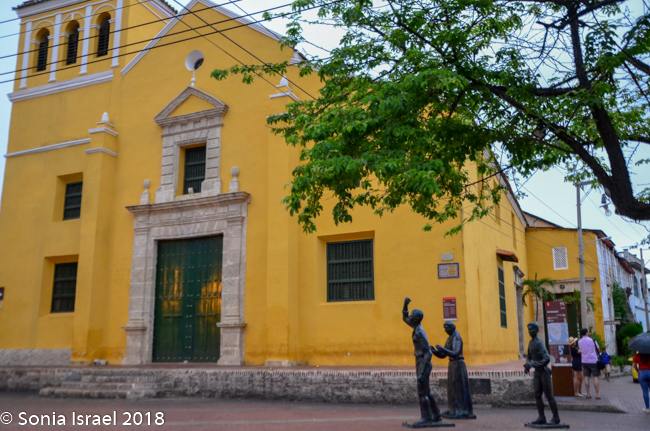 front of the church are three statues, of a monk, of a young boy and of a man with his fist raised to the sky. That is Pedro Romero, the hero of Cartagena’s independence movement for the people of Getsemani, Lanceros de Getsmani.
front of the church are three statues, of a monk, of a young boy and of a man with his fist raised to the sky. That is Pedro Romero, the hero of Cartagena’s independence movement for the people of Getsemani, Lanceros de Getsmani.
Pedro Romero
Pedro Romera was a Cuban who came to Cartagena in the 18th century as a free man of color, that is, a mulatto of mixed African and European descent. He worked  as a gunsmith and master blacksmith in what was then the barrio of Getsemaní, where many of Cartagena’s slaves and free people of color lived. Because he was a great artisan, he was wooed by the upper class, having contact with Cartagena’s white creole and Spanish elite.
as a gunsmith and master blacksmith in what was then the barrio of Getsemaní, where many of Cartagena’s slaves and free people of color lived. Because he was a great artisan, he was wooed by the upper class, having contact with Cartagena’s white creole and Spanish elite.
Like many artisans in Cartagena, Pedro Romero also achieved a level of social prestige through his service in the local militia. Late colonial Cartagena depended heavily
on men of African descent for its defense. Artisans comprised the vast majority of Cartagena’s black militia members, affording them an additional level of social recognition. As a wealthy artisan and militia member, Romero and his family held a position of distinction in Cartagena. Yet, he became drawn to the side of those fighting for independence for Cartagena and the freeing of the African slaves. He organized the “Patriot Lancers of Getsemani” who, along with other groups, demonstrated and fought the Spaniards. In 1811, Romero organized the men of Getsemaní in front of the neighborhood’s church, and from there entered into the city, broke into the city arsenal and armed the crowd with guns, lances, and daggers, and stormed the Governor’s Palace, forcing the Royal Junta to declare independence.
For the people of Getsemaní today, Pedro Romero occupies an almost a mythical status. The street art that covers the walls near the Plaza de la Trinidad, as well as the statue of Romero in that Plaza outside the church, are a testament and a reminder that Cartagena was at the forefront of the independence movement in Nueva Granada, and its declaration of independence was achieved in no small part thanks to the city’s free people of color, organized by the leadership of Pedro Romero.
Tastes of the local fruit
We continued walking through the narrow streets, admiring the colors of the houses and more street art. There were children everywhere, some shy, some ready to smile and pose for pictures. Vicky wanted to be sure we tasted all the local fruit, fruit she grew up eating but fruit we never heard of. We stopped at a cart overflowing with different fruit. First we sampled a mamon, also known as mamoncillo or Spanish lime (or limoncello or chenet or many other names). It is a small green bruit, a bit larger than an olive. The skin of the mamon is very thin, but hard. Vicky broke it open and we scooped out the inside with our teeth and tongue. It was orange/yellowish, creamy and sweet and tangy. The second one we tasted was a zapote, a roundish brown fruit which was brown and rough on the outside, The inside was a dark orange, creamy with two large seeds. The flavor was one I would describe as strong. Likely an acquired taste.
El Joe Arroyo
We passed one more large, 14-foot statue, of a very tall man, in baggy blue jeans and a green t-shirt with both arms outstretched. It was a statue of El Joe Arroyo (Álvaro José Arroyo González, better known as Joe. Joe was a famous Cartagena salsa singer and composer who was considered one of the greatest performers of Caribbean music. He was of African descent and died too young at age 55.
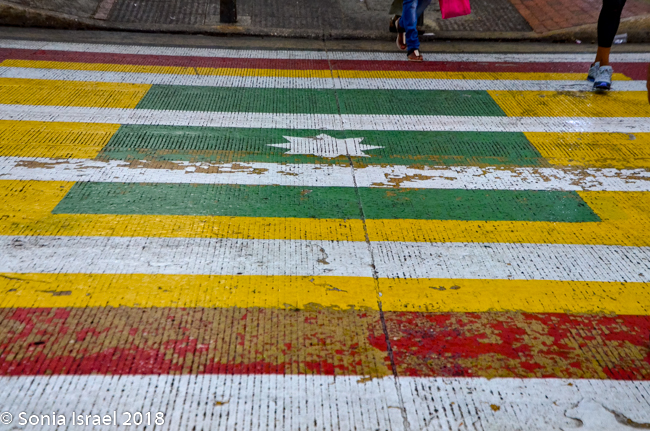 And the crosswalk near him was
And the crosswalk near him was 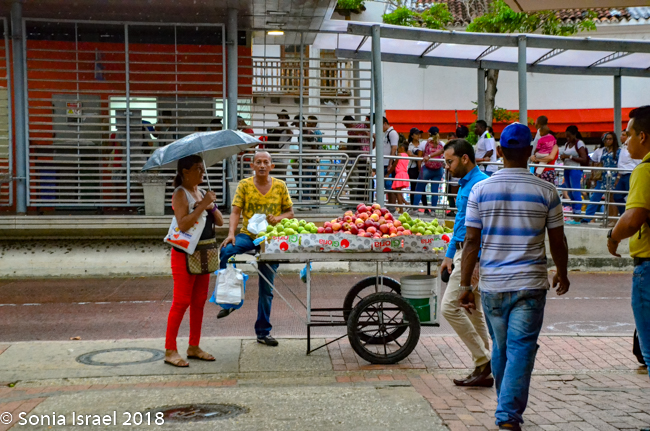 painted just like the Colombian flag.
painted just like the Colombian flag.
The day is ending
We kept walking, making our way slowly back to the hotel. The day was ending. The crowds swelled as people were heading home. We were now near one of the main train stations and the lines to get on were long.
We walked back to our hotel, watching the sun slowly set. When we arrived, we went up to the top level, to the pool area, to see the view of the church all lit up as the sun set.
La Mulata
That night we wanted to eat at La Mulata, back in the Walled Town, just a few blocks from our hotel. They don’t take reservations and it opened at 6:30. We had stopped there earlier in the day with Vicky who read us the menu, told us the best things to order and told us to be there before 730 as that was when it would start getting packed.
We walked the few blocks through the now crowded streets as both locals and tourists were heading for food and drink and shopping. We passed one of the night  markets, lightly lit so it looked like everything glowed. We got to the restaurant at seven and they were already only a few empty tables available. There were several rooms and it looked like this was once a home now converted to a restaurant. The walls were thick and white and covered in all sorts of art and the floor was large black and white tile. The tables, all close together, were carved of beautiful wood. We quickly made friends with the people at the tables next to us. The couple on our left were from San Diego. Small world! The group on our right were six women on holiday, all ordering large, beautifully colored drinks. I have no idea what they were.
markets, lightly lit so it looked like everything glowed. We got to the restaurant at seven and they were already only a few empty tables available. There were several rooms and it looked like this was once a home now converted to a restaurant. The walls were thick and white and covered in all sorts of art and the floor was large black and white tile. The tables, all close together, were carved of beautiful wood. We quickly made friends with the people at the tables next to us. The couple on our left were from San Diego. Small world! The group on our right were six women on holiday, all ordering large, beautifully colored drinks. I have no idea what they were.
We were served complementary plantain chips with some wonderful dipping sauce. As instructed, we ordered the traditional beef medallions with rice with coconut milk and guacamole, and fish of the day, which was seabass, also served with rice and guacamole. While we waited for our food, I had a Mojito which was wonderful. The entire meal, including a bottle of water, was $34. And delicious!
